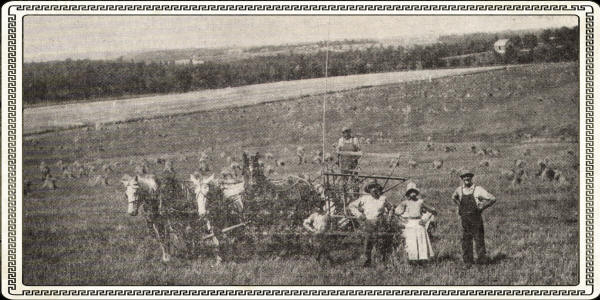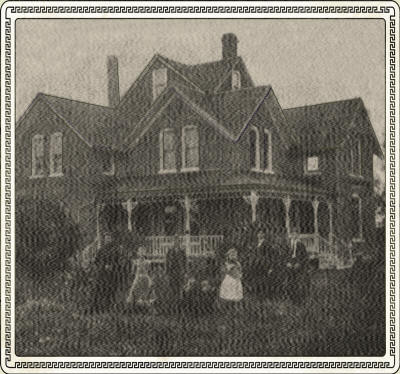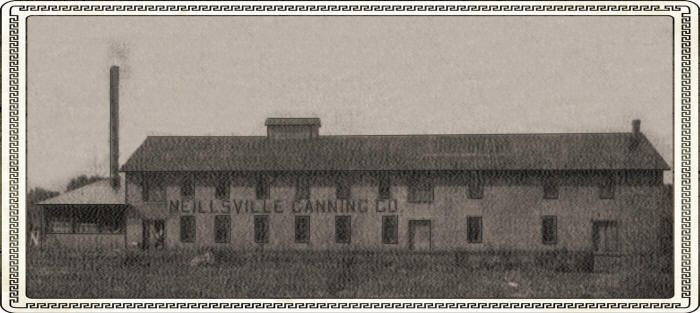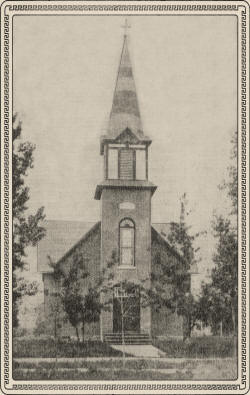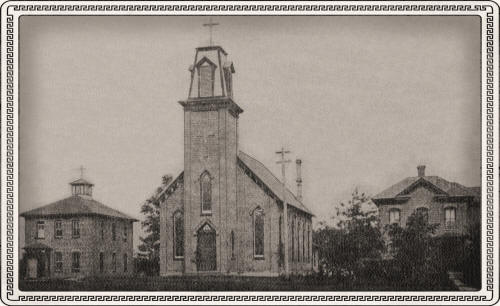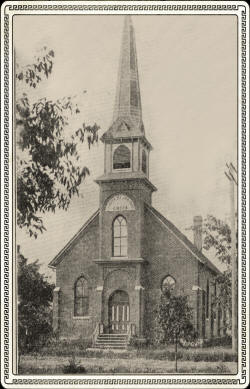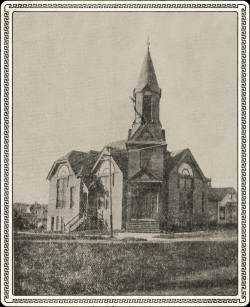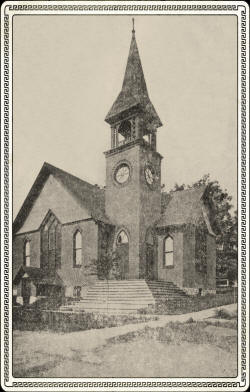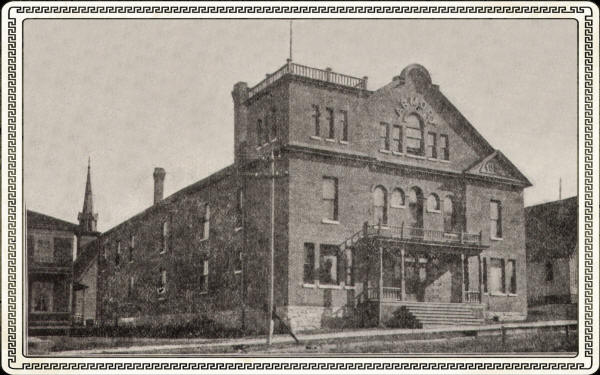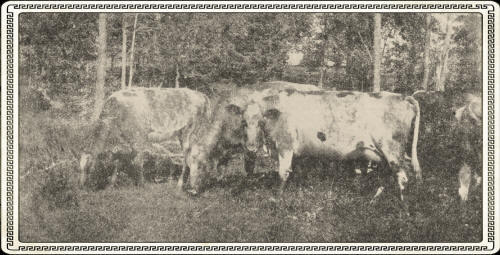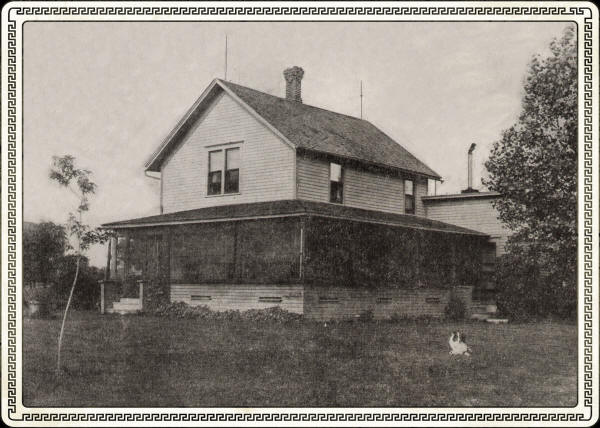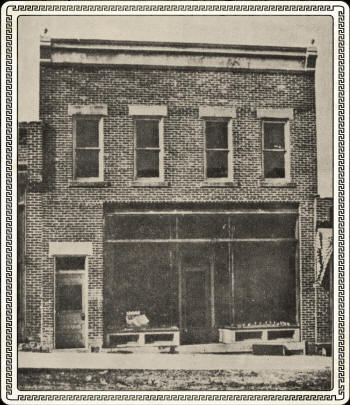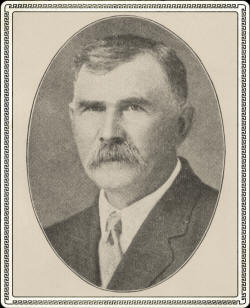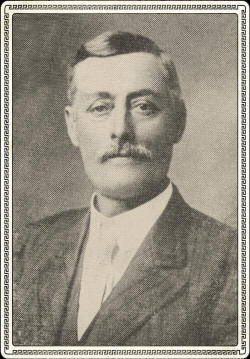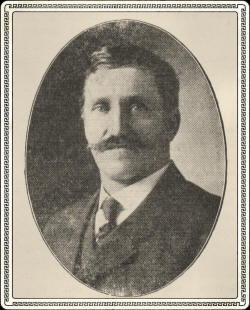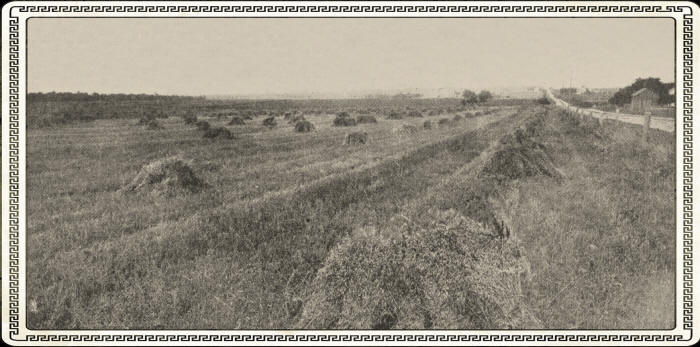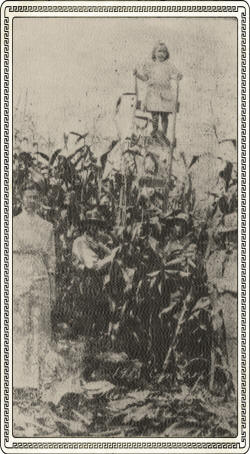[1915 Clark Co., WI West 1/2 & Legend] [East 1/2]
Its Inspiring Past, Prosperous Present, and Its Glorious Future
Clark County was named after the intrepid explorer who in the Lewis and Clark expedition, blazed a way across the continent, then a vast pathless wilderness, and proclaimed to the world the wonderful resources of the great area west of the Mississippi. It was created by act of legislature out of Jackson county July 6th, 1853, five years after the state was admitted to the union. It had hut a sparse population at that time and Sew persons dreamed that within two generations it would be far-famed as an agricultural paradise, particularly for dairying and stock raising.
In those early days it was not unknown to fame, however, as the great forests of white pine along the banks of the Black River and its tributaries had attracted the covetous eyes of the pioneer nation builders from the days of the first explorers.
The primitive red men who inhabited the hills and valleys of what is now Clark County were of the Chippewa tribe, the dividing line between them and the more quarrelsome Winnebago being at the confluence of the East Fork with the Black River, near the present county line between Clark and Jackson. The Chippewa were more intelligent and cleanly than the Winnebago, were very friendly to the early white explorers and settlers, and although given to stealing, it was the boast of the Chippewa chiefs that none of that tribe had shed the blood of a white man or his family.
St. Germain was probably the first white man to touch foot to what is now Clark County soil. In the fall of 1836, when he was in his sixteenth year, he hired out in Canada of Wisconsin by the Lake Superior route and was sent south with a party of trappers, passing the ensuing winter on the East Fork of the Black river. Eight years later, In 1844, a number of Mormons, attracted by the immense pine forests, to the American Fur Company and made his way to the then territory came up the Black river, cut a supply of logs, which they floated down to Black River Falls and thence as lumber down the Mississippi for use at Nauvoo in the erection of a great Mormon tabernacle projected at that point. For a year after their departure, Clark County was uninhabited by white men.
It was in the spring of 1845 that the first white persons who became permanent settlers, arrived in Clark County. James and Alexander O’Neill. who had come in 1839 from New York state and stopped at Prairie du Chien, decided to push on and found a new community of civilization in the wealth of the trackless wilderness to the north. They loaded a canoe with provisions and some meager household goods and proceeded up the Mississippi and up the Black river to Black River Falls, erected a mill and for six years did a large and profitable business. Six years later, in 1845, they decided to push still further on and James and Henry O’Neill, with E. L. Brockway, Samuel and William Ferguson and a number of laborers, came to the site of the present city of Neillsville and became the first settlers of Clark County. They came overland In a wagon drawn by an ox-team cutting their way through brush and over fallen logs and were two days on the trip. This was the first road ever made in the county.
At that time, the wilderness into which these pioneers had come, was full of game — deer, wolves, otter, mink, beaver and martin. The kindly Chippewa made the newcomers welcome. A rough cabin 18x24 was erected on the bank of O’Neill creek near where the mill was soon afterwards built, about where the Merchants Hotel now stands. The mill had one upright saw with a capacity of 4000 feet a day. The lumber was rafted to the foot of the creek and there combined and arranged and sent on down to the falls, where large rafts of 40 to 50 thousand feet were run on down to Burlington, consigned to Alexander O’Neill, the elder brother of the lumbermen, who sold the product at an average price of $10 a thousand.
The next year few newcomers settled in Clark County, but James O’Neill built a more commodious house, on the site of what is now the Brooks residence. The old log house was undermined by the stream, fell and floated down towards the Mississippi. During this second year, Mr. O’Neill tired of trying to keep house without the aid of woman’s skillful supervision, induced Mrs. Robert Kennedy, accompanied by her husband, to take charge of his household and so the first argument for woman’s suffrage following shortly after the first settlers in Clark County.
The Mormons had retained their interests in the pine forests along Black river. One of them named Cunningham slipped into the creek while logging and was drowned, and the creek is known to this day as Cunningham creek. His was the first death of a white man in Clark County. In 1846 Andrew Grover together with Hamilton McCullom and a man named Beebe, built a mill on Cunningham’s creek two miles below Neillsville. Jonathan Nicholas and John Perry and wife located in what is now the town of Weston. It was in 1846 that James O’Neill courted Miss Jane Douglas, much to the rejoicing of the little community. This happy event followed and presumably was occasioned by a Christmas Eve dancing party at Mr. O’Neill’s house, to which everyone was invited. Miss Douglas was one of the guests and the dance was kept up till dawn, when the host escorted the young lady, who undoubtedly was the belle of the ball, to the Douglas farm, near Melrose, going down Black River on the ice, and no young swain or maiden now resident of Clark county, can doubt that the witchery of the early morning ride, the tingle of the snappy dawn, the echo of the merry fiddlers, and the innate desire of sturdy men and lovely women, led this pioneer to make the proposition which led to the first holy union of matrimony of Clark County settlers. It was not performed in Clark County, however, the ceremony being at Melrose in Jackson county by a Justice of the Peace, on March 7, 1847. The happy couple came to Neillsville to live, however. The first marriage In the present limits of Clark County is said to have been performed the same year when Simon Winfield took to wife a girl in the employ of Mr. O’Neill, but they soon left the community and were heard of no more.
In 1847 there were but few newcomers. Among them were Samuel Cawley who gave his name to Cawley Creek; I. S. Mason, Thomas La Flesh, Nathan Myrick, H. J. (Scoots) Miller, and a man named Dible (Dibble) who built a mill on Cunningham creek. Jonathan Nichols built a mill on Cawley creek. On June 7, 1847 there was a disastrous flood which practically washed away all the improvements so laboriously planned and executed, and it was about this time that the first murder in the county occurred. Bill Flynn, a logger, became involved in a drunken row with a Chippewa Indian and so injured him in a hand to hand encounter that death ensued. Flynn fled and was never apprehended.
In 1848 the emigration to Clark County brought J. W. Sturdevant, Mr. Van Dusen, Mr. Waterman, Leander Merrill, Benjamin Merrill, John Morrison, probably Moses Clark, John Lane, Robert Ross, Elijah Eaton, Albert Lambert and perhaps a few others. The Merrills built a mill, also Lane, also Morrison, and Myrick and Miller had already built one. Van Dusen and Waterman began milling 181 miles above Neillsville and so did Albert Lambert. Later Elijah Eaton bought the Van Dusen mill and operated it for years, giving his name to the town of Eaton. In March 1849 Isabella Jane O’Neill was born to James and Jane O’Neill, the first birth in the county, and the most important arrival of that year.
In 1850 about 50 acres of land was cleared including the ground where the school house now stands and little by little the mill owners added agriculture to their logging activities, and with such good results that one clearing appeared after another rapidly. The California fever at this time prevented emigration to Clark County and few if any new comers appeared for several years, and as a rule the lumber jacks refused to stay after the run of logs had been started. The prospects that Clark County would ever be dotted with fully developed farms with commodious houses, immense barns and silos, with herds of thoroughbred cattle grazing the broad acres, seemed poor indeed, and it is doubtful if even the most sanguine of those pioneers ever dreamed of the development which has actually taken place in two or three generations. In those days all supplies came from LaCrosse, Burlington, St. Louis and other markets, landed at the mouth of Black river and laboriously poled tip the swift current in craft of the most primitive construction.
It was in 1853, on July 6th, that Clark County was created out of Jackson county, with the same area which it now contains, except that the north tier of towns was added from Taylor county in 1875. When organized, the county had but a single town — Pine Valley — and James O’Neill was chairman of the board of Supervisors and Hugh Wedge and James French were side supervisors; B. F. French, treasurer; Samuel C. Boardman, clerk. It was in this year that Samuel Weston with David Robinson came from Maine and located above Neillsville and established a village. Later he gave his name to the town of Weston. When the proceedings to have the county created were pending, the petition to the legislature that the county seat be located at Neillsville, was changed some way and Weston was substituted for Neillsville in which shape the petition was granted. As can be readily understood, this created consternation, indignation. and determination to offset the alleged treachery. An act of legislature was passed authorizing the people to vote a change from Weston to Neillsville and a lively struggle took place. There were two polling places, O’Neill’s tavern at the village and Parker’s tavern, 11 miles below and according to reliable reports imported voters were not rejected, The result at the Neillsville polling place was 4 majority for Weston while at Parker’s the vote resulted 21 in favor of Neillsville, making a net lead of 17 votes out of 104 cast, for Neillsville, thus determining probably for all time the location of the metropolis and county seat of the new county. In the fall of 1854 G. Hall was elected sheriff, B. F. French treasurer, S. C. Boardman county clerk and register of deeds. Chauncey Blakeslee as county judge was soon succeeded by R. Dewhurst. New arrivals came each year and the town of Levis was apportioned in 1857, Weston in 1859, Lynn in 1862, Loyal in 1863, Mentor in 1867, Grant in 1868, Eaton in 1870, Beaver in 1871; York, Hixon and Sherman in 1873; Colby, Unity, Mayville and Washburn in 1874; Sherwood Forest, Hewett and Warner in 1875; Thorp in 1876, Withee in 1880 and the newer towns in comparatively recent years. At the new county seat Jas. O’Neill appropriated four acres to village purposes and the same was surveyed and platted by Allen Boardman, surveyor. There were only two or three cabins, Robert Roix’s hotel, Dr. Baxter’s hut, and the humble domiciles of Jas. O’Neill, Nathan Boardman, Nathan Clapp, B. F. French and Mr. Dickey.
The growth in population was slow. Indians abounded and rough characters came for a season or two in the woods and went again. A man named Pattengiil with his partner, Page, engaged in an altercation with Indians during which three of half breed was shot at Hunsicker’s (Huntzicker) the red men were killed and later a tavern 12 miles north of Neillsville. The chief made complaint to Mr. O’Neill but nothing was done about it. In 1856-7 the settlers suffered hard times. Money often became worthless in a day and wages dropped to nothing. From 1857 to 1865 there were more exits than entrances upon the Clark County stage, but after the civil war, the value of lumber appreciated and a large number of new comers were attracted to the immense pine forests. In 1867 the village of Greenwood was laid out, and in 1869 Humbird was apportioned. Neillsville grew very gradually until 1876 when it began to develop more quickly, due to the railroad from Humbird. The first court house was of frame, two stories high, 40x50 in dimension, built at a cost of $1800 and located in the center of the village. In 1875 it was removed and the present handsome structure erected of brick, 2 stories high and surmounted by a cupola on which a statue of Justice stands. It cost $35,000. The county jail was built in 1881. The county farm was located in the town of York in 1880, 160 acres of fertile land with a large house and several barns and out buildings which makes a model institution for the care of the indigent.
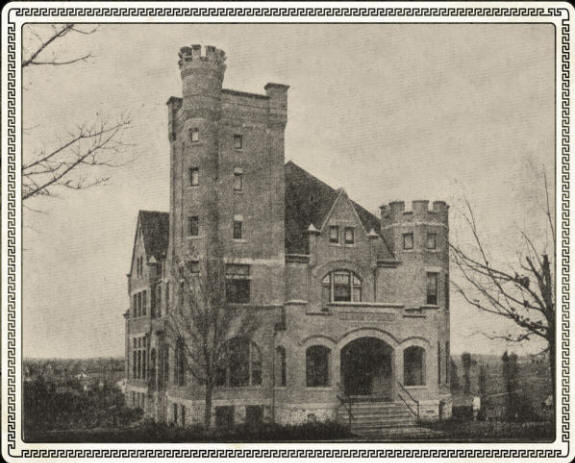
Clark County Jail House, Neillsville.
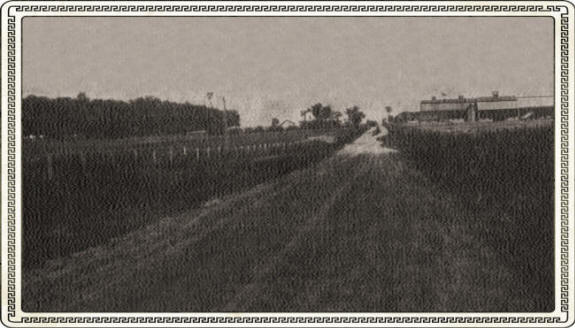
Clark County Poor Farm, Town of York
In 1857 William C. Tompkins was induced to locate in Neillsville and established the pioneer journal of the county, — the Clark County Advocate. In 1861 The Union and Flag was published by Dore & Dickinson, and in 1867 the Clark County Journal made its appearance, and later in the same year the Clark County Republican. In 1873 the Clark County Press was started and later combined with the Republican and still appears weekly as the Republican and Press. The Enterprise of Colby represented the northern part of the county during the early years, but succumbed and in 1879 the Colby Phonograph was established. The True Republican was started in Neillsville that year and later became the Neillsville Times, and in 1880 the Deutsch Amerikaner made its appearance and has continued since, the sole publication in the German language.
The Clark County Agricultural Society was organized on March 15th, 1873 and bought forty acres of land just outside of Neillsville on which an adequate grand stand and buildings for the annual exhibitions have been erected.
The county includes a rectangular area seven townships long and five ranges wide, being towns 23 to 29, inclusive and ranges 1 east to 4 west inclusive, except the town 23, range 4 west, in the south-western corner of the rectangle, which is a part of Jackson county. Clark County is just northwest of the center of the state. It is traversed by three principal railroads doing business in the state and by two smaller roads, affording easy communication in all directions. The construction of the first railroad in the county was the result of long contemplated action by Clark County people, the organization of the Black River Railroad Company resulting on Feb. 26, 1878, H. N. Withee, James Hewett, Daniel Gates, F. D. Lindsey, R. J. McBride, J. L. Gates, G. L. Lloyd and F. S. Kirkland being the incorporators. The capital stock was $150,000 and the survey was made and work commenced at once. The town of Pine Valley consented at last, after declining once or twice, to issue bonds to the extent pg $10,000 aid the project, while the towns of Weston and Hewett agreed to chip in $1000 each. On account of some complications, Weston and Grant declined to renew their offer which had expired, but Pine Valley and Hewett extended the time and the work wont on, and on July 4, 1881 the first train made its advent into the county seat from Merrillan and was greeted with appreciated welcome.
And then the old tote road from Humbird to Neillsville over whose corduroyed levels and planked hills the supplies for the county seat and surrounding camps had been transported for years, began to fall into disuse and decay.
Clark County is for the most part gently undulating in surface— drained by the Black river, (so-called because its waters take a dark tinge from the swamps where it rises) which flowing from north to south divides the county into nearly equal parts, and by the branches of the Wisconsin river in its eastern part and by the effluents of the Chippewa river in the north western section. The pineries were located along the banks of the streams and hard wood ridges extended across the county. The soil in the northern, central and south central portions is a rich clay loam and in the southern part a sandy loam. The streams afford practically inexhaustible water power, only a small portion of which has been as yet developed.
The only one of the silurlian formations occurring in this county is the Potsdam sandstone which forms the basement rock of its southern portion, the primary rising to the surface in the northern portion. High bluffs of sandstone occur in several localities in the county, making pleasing land marks distinguishable for miles around.
The present county officers are: Sheriff, Louis Hantke; Clerk of the Court, ‘George Ure; County Clerk, Myron Wilding; Judge of the Probate 0-curt, Oscar W. Schoengarth;
County Superintendent of Schools. Miss Elizabeth Kennedy; County Treasurer, Ole C. Anderson; Register of Deeds, E .J. Rossman; District Attorney. W. 3. Rush; Member of Assembly, Emery W. Crosby; Sup’t. of County farm. M. Redmond.
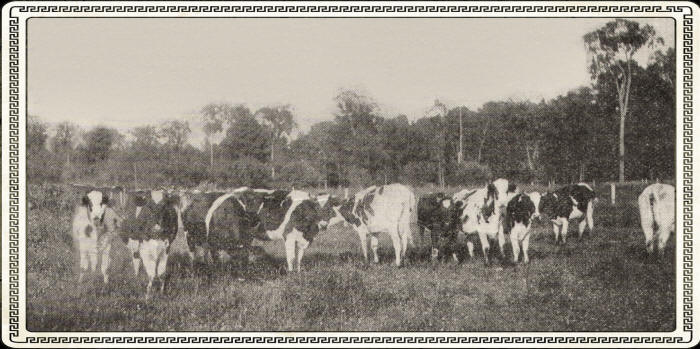
E. R. Wonser's Pure Bred Holsteins, Town of York.
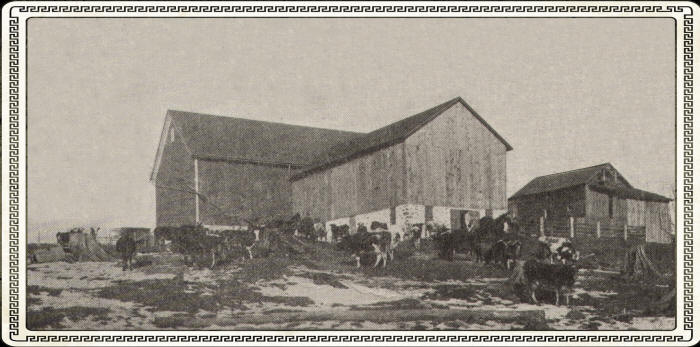
Fred Fischer's Farm, Town of Worden.
And as for the future of Clark County, what pen is bright enough, what ink clear enough, what hand firm enough to write the things which must come judging from the past of this and other communities. Withal the noble stretches of fully developed farm lands, with all the commodious farm houses, big red barns and round silos, herds of thoroughbred cattle, cheese factories or creameries on almost every other corner, with all wealth of $30,000,000 among the 4500 farms and the score of prosperous towns and village’s — with all these facts, Clark County is but about one-half developed. There are still wide areas of undeveloped land and many of the farms are still but partly improved. Land values which have doubled during the past seven years now range from $40 to $125 an acre for improved farms, and from $15 to $30 for undeveloped land.
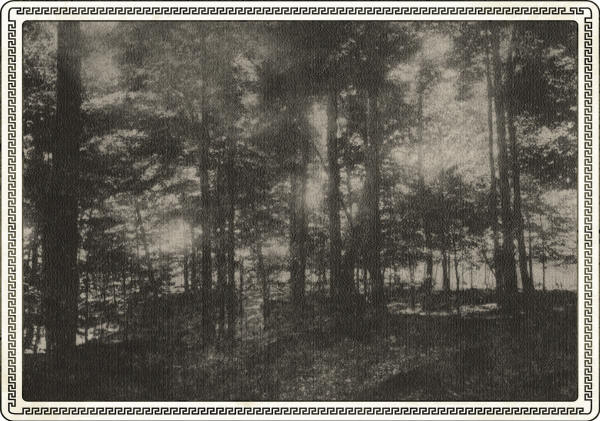
Large Areas of Undeveloped Land Still Open for New Settlers.
What will Clark County be, what will land values be, when the 783,360 acres are fully developed? What will the products be— from the farms, from the herds, from the creameries and cheese factories ? What will the revenues be when the water powers are harnessed to buzzing dynamos?
Clark County in central Wisconsin is destined to be one of the wealthiest and most prosperous counties in the country— a garden spot of the world.
WELL KNOWN MEN OF CLARK COUNTY, WISCONSIN
Anderson, O. C., County Treasurer [Photo]
Berg, C. C., Granton [Photo]
Clark, Homer C., Neillsville [Photo]
Cresswell, Dr. W. B., Neillsville [Photo]
Crosby, Emery W., Assemblyman [Photo]
Davis, Fred W., Granton [Photo]
Devos, A. L., Neillsville [Photo]
Graves, A. A., Loyal [Photo]
Hantke, Louis, Sheriff [Photo]
O'Neill, Hon. James, Judge of the Circuit Court [Photo]
Rossman, Elmer, Register of Deeds [Photo]
Rush, W. J., District Attorney [Photo]
Schoengarth, O. W., County Judge [Photo]
Sniteman, C. C., Neillsville [Photo]
Ure, George A., Clerk of the Court [Photo]
Wilding, Myron E., County Clerk [Photo]
Woelffer, Victor C., Neillsville [Photo]
Zimmerman, J. G., Neillsville [Photo]
AGRICULTURAL OPPORTUNITIES IN CLARK COUNTY, WISCONSIN
By R. A. MOORE, Professor of Agronomy, University of Wisconsin
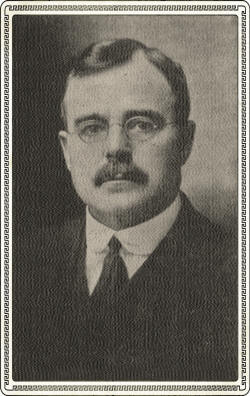
R. A. Moore
No single county in Wisconsin has made more progress in the past twenty years than Clark County. Fifty years ago practically the entire county was covered with a heavy growth of timber. This was a bonanza for the lumbermen, and many people felt at that time when lumbering interests were a thing of the past that the cut over lands would be a serious problem to overcome, but such has not been the case. It is found that at the present time more valuable crops have been harvested each year from these formerly cut over lands than the timber that had taken centuries to produce. Such was the fertility of the land upon which this mammoth was located and it has responded to the intelligent culture to such an extent that wonderful crops of clover, corn and field grains repay the farmers bountifully for their toil and investment.
Clark County Harvest Scene.
From actual experience in visiting the county from time to time during the past twenty years It pleases rue very much to bear evidence of the rapid progress being made upon these fertile lands. Really, one marvels to think of the great change that has come over this country during the past few years. From the little cabin of the woodman with his few acres the clearings have gradually expanded until now we find some of the most fertile and productive farms of the state within in the borders of Clark County. The cultivated lands have risen in value so that we find them fully as high in Clark County as they are in any other portion of the state. There also are immense opportunities in Clark County as there are great tracts of cut over land that are just as good as some of the lands which have been converted into farms that can be purchased at reasonable rates. Wisconsin is certainly fortunate in having a county which has yet for its young people opportunities of securing land that cannot be surpassed anywhere in the entire world.
A Typical Clark County Farm House.
The moderate climate together with the fertile soils make Clark County especially fitted for growing the pedigreed seed grains. Many of the young boys upon the farms of Clark County have been made happy by growing the most beautiful corn in the world known as the Golden Glow. This seed corn finds a market every year and has been the means of carrying encouragement to our stock raisers over the entire state. The beautiful pedigreed barley and other pedigreed seed grains grow to perfection in Clark County and offer an opportunity that can not be surpassed in any other portion of the world.
As a dairy section in Wisconsin Clark County hands out an opportunity that welcomes you in the work. Her great amount of beautiful hard wood lands which have been converted into fine farms, and her beautiful clear running streams and springs are factors that, add greatly to the dairy interests of this section of the state. Already beautiful pure bred herds are known almost everywhere in the county, and farmers are becoming known prominently for the efforts they have put upon grading up the herds and putting in pure bred stock. As a matter of fact the farmers of Clark County are determined to banish forever from their farms scrub seed grains and scrub stock and put In the place only those breeds of grain and cattle which have had long, patient breeding work placed upon them. The rapid progress which has been made in the past, together with the great opportunities yet afforded in Clark County, makes it attractive for the people who are now liv1ng within its borders and those who wish to come and find homes for the future.
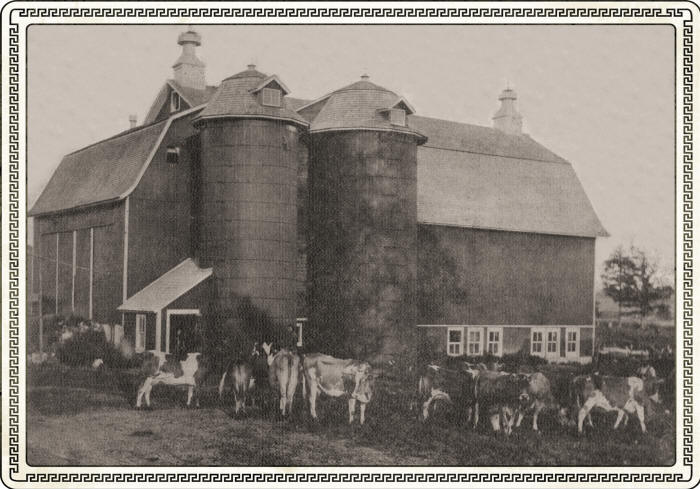
Herd of Pure Bred Guernseys and Model Barn on the W. Scott Davis Farm, Granton.
ROAD BUILDING IN CLARK CO.
By WM. C. THOMA, Neillsville, Wis., Road Commissioner for Clark County
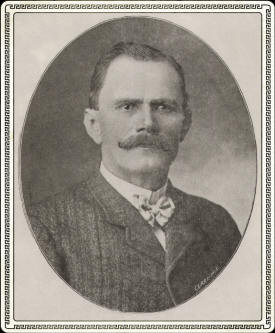
W. C. Thoma, County Road Commissioner.
Who has done a lot during the past four years to pull Clark County out of the mud.
Note the pictures of good roads in this book.
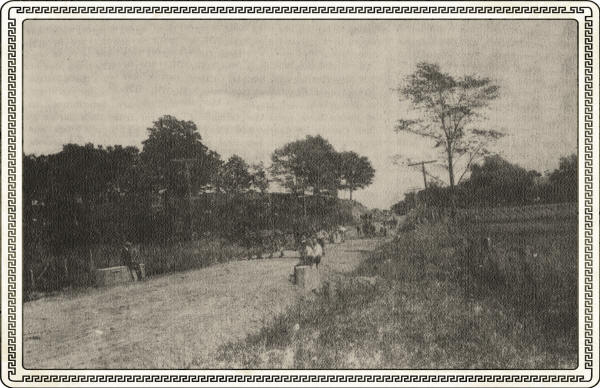
William Thoma's Crew at Work on Road Between Granton and Lynn.
One of the features of Clark County is its good roads. Travelers from other parts of the state and of the country— especially automobile tourists— admit when they come into this “Heart of Wisconsin” that in the matter of good thoroughfares we are well in the lead.
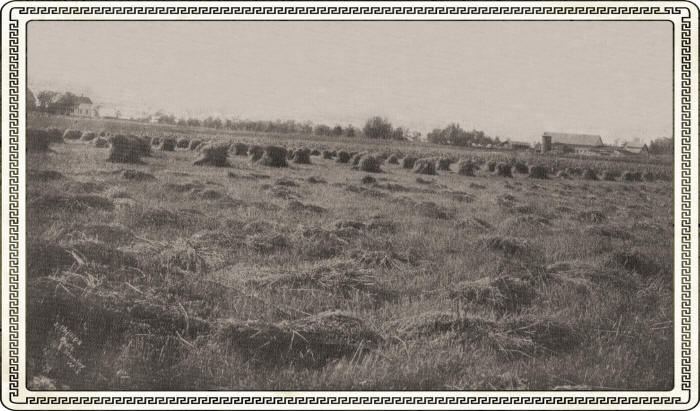
Harvest Field in "The Heart of Wisconsin."
During the past four years the county has been working under the new system of state aid for road making, the county board having adopted that system in November, 1911. Work commenced the next spring. During 1912 and 1913 only grading and building of culverts was undertaken, but in 1914 and 1915 nearly a score of miles of surfaced roads have been made and the prejudice which at first existed against the new plan has gradually disappeared as the residents and tax payers learn from actual experience the benefit of the scientifically built highways.
During the three years eighty-five miles of roadway has been graded and there has been fifteen miles of gravel macadam and two miles of stone macadam and quite a stretch of shale macadam road made; 146 concrete culverts made and thirty- three concrete bridges, at an approximate expenditure of $100,000, of which the state pays one third, the county one third, and the town one third.
A system of state roads has been laid out which when. completed, five or ten years from now, will comprise about 400 miles of macadam road with thirty-three bridges and altogether representing a cost of half a million dollars. This state road system is about fifteen per cent of the whole system of roadways in the county, there being over two thousand miles of road in Clark County, an average of sixty miles in each township.
But it is not for the joy rider by any means that the good road movement is being pushed forward, but for new settlers as well. Roads are being cut through the brush and timber in the newer towns at the rate of five to ten miles a year, In each township and whenever a. newcomer settles down on a forty or eighty of land and shows his determination to stay and make a home, the town board will quickly and gladly give him a good highway to the nearest county road.
The roads are maintained by the towns and county, the automobile license money being appropriated for that purpose. Frequent dragging is the best and cheapest and easiest way to keep up roads when, once used and in Clark County this humble machine is used extensively.
FRUIT RAISING IN CLARK COUNTY
BY FREDERICK CRANEFIELD, SECRETARY STATE HORTICULTURAL SOCIETY
The State Horticultural Society is engaged in promoting fruit growing in Wisconsin and for that purpose has established eleven so-called Trial Orchards or experiment stations of three to ten acres each. These orchards are for the purpose of testing varieties and testing soils and climate conditions.
While none of these orchards is in Clark County, one has been maintained near Wausau on the east and one has recently been established in Chippewa county on the west.
We also had an orchard for several years in Taylor county, near Medford, and one in Barron county. You will see therefore that even if we have missed your county we have located all around you where conditions are similar to yours.
From my experience in these adjoining counties and from my “car window” knowledge of Clark County I have no hesitation in saying that: A farmer anywhere in Clark county may without difficulty raise all the fruit needed for home use; that certain portions of Clark County seem well adapted for apple raising on a commercial or market scale. The high, rather rolling clay lands In the vicinity of Neillsville appeal to me very much. I feel certain that the standard Wisconsin apples, such as Duchess, Wealthy, Fameuse McIntosh, Dudley, McMahan and other fall varieties could be grown there successfully and profitably. So far as the home orchard Is concerned anyone anywhere In Clark County may have all the fruit he needs of the kinds commonly grown in Wisconsin.
Some months ago the editor of a paper in a county adjoining yours asked me to outline the fruit situation in Northern Wisconsin and my letter to him seems to fit so closely your attention that I submit it herewith:
“There are two classes of farmers to be considered: The ones located near a city of some size or at least having good shipping facilities, to some good market, and the “man out in the brush”.
The first named class can often raise fruit or vegetables as a side line, but such growers are not apt to meet with much success unless a number of them unite in selling. The lone fruit grower Is absolutely at the mercy of the retailer or the commission man, as the case may be. Co-operation partly solves this problem. I am not much inclined to favor fruit growing for market by farmers in Northern Wisconsin outside of the Bayfield peninsula and Door county where the business is organized, unless the conditions are extra favorable and unless a considerable number in one locality are engaged in the business and organized for the purpose of selling.
The settler, the farmer large or small, who is hewing a home out of the brush and stumps in Northern Wisconsin Is the one who needs help and for him we are prepared to do our utmost. Each and everyone of these pioneers should be doing something toward establishing both an orchard and a small fruit garden.
The Northland of Wisconsin is the land of berries and bush fruits. Here strawberries, raspberries, currants and blackberries grow and bear as nowhere else in the state.
There are two ways for the Northern Wisconsin farmer to start, the theoretical and the practical. Theoretically he should plant an orchard, trees 20 to 25 feet apart, cultivate it thoroughly without intercropping until mid July and then sow a cover crop of oats or vetch. He should proceed in much the same way with the strawberries and bush fruits. Unfortunately he cannot spare all his land and get no returns from it for two or three years.
Suppose we try another plan. Buy a dozen trees, apple, plum and crab and set them about 24 feet apart near the house. Use the space between the rows for potatoes, beans or if must be for grains. If a little judgment is used to avoid over-cropping and a reasonable amount of care in the use of team and tool to avoid injury to the trees the orchard may be cropped for ten years without material damage to the trees and for the first five years without material loss of land.
Fifty strawberry plants will set two rows each 50 feet. These may be planted between the tree rows for the first crop if no other space can he secured. One dozen raspberry plants, six red and six black will be sufficient for a start. Suckers and offsets from these will furnish all the stock needed for enlarging the plantation the second and succeeding years. Three currant and two gooseberry bushes will be enough for a start. The bush fruits may be planted along the outside of the clearing nearest the house if necessary and will do very well there. If grass creeps in mulch heavily with manure in June of July. In this way a good start us made without great expense. This entire bill of stock should cost no more than five dollars. It will be a good substantial start and in fact ao additional stock need be bought for several years if the trees live. But If this seems too much cut it down just one half all along the line and there will be a very respective showing. Here follows an outline toning what to buy, how to buy and how to plant.
WHAT TO BUY
2 crabs, 1 Whitney and 1 Hyslop,2 plum, 1 Se Soto and 1 Surprise
8 apple, 2 Duchess, two Patten Greening, 2 Wealthy. 2 Malinda, all two year old trees.
50 strawberry, 25 Dunlap, 25 Warfield, 6 raspberry (red) Cuthbert or Marlboro, 6 blackcaps, Greg or Kansas, 3 Perfection currant, 2 Downing gooseberry.
HOW TO BUY
(1.) If a nursery agent calls show him your list and ask him to give you the lowest cash price on whole or half of the lot f. o. b. his shipping point without any premium or guarantee nonsense attached. If it is over five dollars let him go.
(2) Send your list to a reliable Wisconsin nursery and ask for prices.
HOW TO PLANT
Plant the trees early, just as early as the ground can be worked In the spring. No fall planting. The fruit trees ought to be planted about 20 feet both ways. Trim the roots a little before planting and trim the tops after planting. Cut off two- thirds of the tops. Failure to cut back the tops immediately after planting is the commonest cause of trees dying.
Set strawberry plants two feet apart in the row and the rows four feet apart. Don’t cover the “crown” or growing center in planting nor leave roots sticking out. Plant berry bushes at least 4 feet apart. Keep out grass and weeds, keep the soil stirred, grow a crop between the trees and vegetation between the berries and bushes also If so desired, have faith and above all ASK QUESTIONS. The State Horticultural Society answers questions free of charge.
The City of Neillsville
The County Seat of Clark County
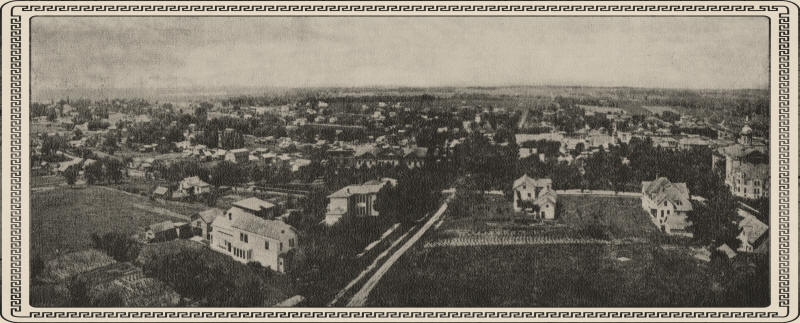
Birds Eye View of Neillsville.
Like a sparkling gem In a beautiful setting or like a master’s picture in a beautiful frame, the city of Neillsville, county seat of Clark County, presents a most attractive sight nestled among the green hills and in the midst of wide expanses of fertile acres, where the dark currents of Black river tossing over the rocks mingles its murmuring with that of placid O’Neill creek. On a railroad which brings three passenger trains each way each day—one each way a through train from the metropolis of one state to that of another—sod with good improved roads leading out in each direction, north, east, south and west, to stretches of as fine farms as can be found anywhere in God’s green earth, with its court house surmounted by the blindfolded holder of Justice’s scales and its other public buildings outlined against the sky or against the background of encircling hills, with its blocks of busy marts and its streets of beautiful homes, surely Neillsville can take pride in the fact that it is a truly representative American city, a Wisconsin municipality, a Clark County capital, a city which has a history of which It Is not ashamed and a prospect for future growth and development which is its pride, boast and hope.
The early history of Neillsville is so closely linked with that of Clark County that to relate it would be but to repeat much that is written in another article. Since about the year of 1876, however, the county seat has had its own experiences aside from those of the whole county. Until the first railroad came to open easy communication with the outer world, it often occasioned surprise on the part of a traveler who arrived overland from the nearest railroad town to see a New England village here in the Northern woods. The village was laid out and platted in 1855 by James O’Neill and named after him.
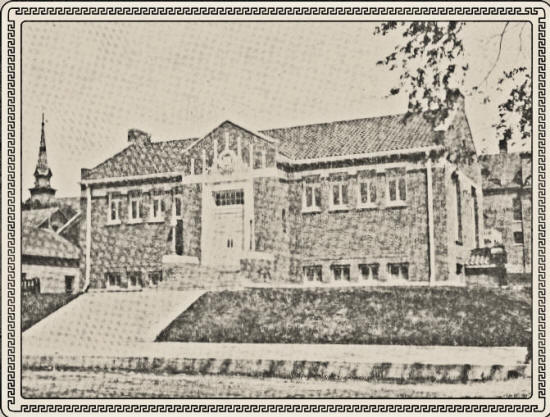
New Carnegie Public Library, Neillsville, Wisconsin.
|
The main business section is Hewitt street, named after James Hewitt, one of the pioneer settlers, The city lies back nearly a half mile from the banks of Black river but O’Neill creek runs nearly through the center of town circling from west to east, dividing it into the north side which contains the Catholic church and school, the cemetery and some of the desirable residence blocks, and the south side which comprises the business streets, the county buildings, high school, new Carnegie library, and many new and very beautiful homes.
Plant of the Neillsville Canning Company.
Neillsville has three banks, four dry goods stores, two drug stores, four hotels and a boarding house, six or seven grocery stores, three hardware stores, four implement houses, two automobile garages, sixteen saloons, a farmers co-operative elevator and lumber yard, a farmers’ cooperative creamery, another creamery and cheese factory corn- blued, a flour and feed mill, wagon factory, four blacksmith shops, one steam laundry, three restaurants, a canning factory, two potato ware houses, one cheese warehouse, one brick yard, overall factory, 2 English and one German newspaper, a Catholic church and school, a Lutheran church and school, Presbyterian, Methodist, Congregational, Christian Science and Episcopal churches, High school and 2 graded schools, three harness shops, two meat markets, two variety stores, two furniture and undertaking establishments, four barber shops, one moving picture theatre, a brewery, a planing mill, two pop factories, four doctors, three dentists, eight lawyers, three real estate dealers, two abstracting firms, one cigar factory, three dray lines, one monument manufacturer, five shoe repair shops, two electrical workers, two plumbing shops, one ice house.
|
|
|
Norwegian Lutheran Church, Neillsville
|
Catholic Church, Neillsville |
|
German Lutheran Church, Neillsville. |
Congregational Church, Neillsville. |
Methodist Church, Neillsville.
|
The Armory, Neillsville.
There is a large armory for the use of the company of militia, which is also used for at theatre and hall for dances. This is owned by a local stock company.
The city owns and operates the water works, procuring its supply from Black River, and there is an adequate system of sewerage, and the electric light and power Is furnished to the city and private consumers by a subsidiary to a large company, the energy being derived from water power a score or more miles distant.
The present city officers are: Mayor, Fred Self; city clerk. Levy Williamson; city attorney, Homer C. Clark; Marshall, Alfred Hauge; city treasurer, William Huntley Jr.; aldermen, Robert Kurth, Win. Goeden, H. E. Bartell. Peter Warlum, E. A. Holcomb, Geo. Trogner; poor commissioner, Peter Johnson; health officer, Dr. H. L, Bradbury, school commissioners, George H. Crothers, Mrs. J. W. Hommel and C. R. Sturdevant. Postmaster, Wm. Huntley.
There are chapters of the Masonic order, Odd Fellows, Woodmen, Beavers, Moose, and kindred organizations, and numerous social, civic and benevolent associations. A good city band of 30 pieces is supported by the citizens.
Neillsville has recently attracted considerable attention throughout the country because of the starting of a so-called community movement, a community secretary being employed
to promote the general welfare of Neillsville and the surrounding country. Organizations of the business men, farmers, women and others are subsidiary to the central organization and efforts made to stimulate the development of the community along industrial, educational, agricultural and recreational lines.
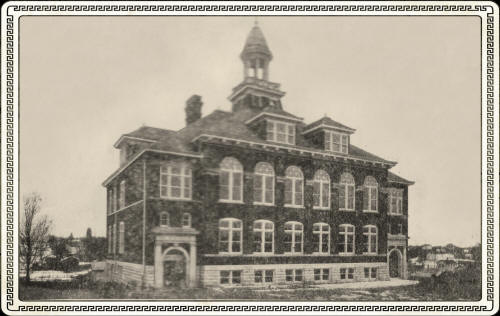
High School Building, Neillsville, Wisconsin.
The future of Neillsville is destined to be that of a prosperous, enterprising, steadily developing city in which values are bound to increase — not by any boom or by exploitation but by the growth in value of the surrounding country as the county develops, It is probable that water power will be utilized in the future and that the hum of industry In many mills and factories will supplement the prosperity of the farmer, dairyman and stock raiser. The eminent success of the canning factory and of the elevator and feed mill and of the co-operative creamery is a proof of the intelligence and enterprise of the citizens. The population of Neillsville is about 3000.
Business Directory
Aichinger, John, Saloon.
Albright & Schultz, Groceries.
Badger State Telephone and Telegraph Co. [Advertisement]
Bast, Joseph, Bakery.
Berger, H. & Co., Variety Store. [Advertisement]
Bishop, J. B., Tailor.
Bradbury, Dr. H. L., Physician.
Brameld, T. H., Real Estate.
Brauer, Rob, Clothing.
Brooks, Dr. J. H., Dentist.
Bruley, Mrs. H., Millinery.
Bradford, C. M., Merchants Hotel.
Carter, John W., Sporting goods.
Cash Hardware Store.
Clark, Homer C., Lawyer.
Commercial State Bank.
Coleman, Rev. L. B., Clergyman.
Cook, Chester, Restaurant.
Cresewell, Dr. W. B., Dentist.
Crothers & Tilt, Pub1ishers.
Crosby, B. W., Attorney.
Cummings, Gertrude, Photographer. [Advertisement]
Dangers, Fred, Grocer.
Dangers, B. & Co., General Store.
Darling, A. R., Restaurant.
Day Creamery Co., Butter & Cheese.
Devos, L. A., Attorney.
Dwyer & Kurth, Meats.
Eberhardt, H. H., Furniture and Undertaking.
Epling, F. J., Insurance.
Farmers Co-Operative Elevator Co.
First National Bank.
Frank, Dr. J. H., Physician.
Gangler, Nick, Variety Store.
Gluch, August, Grocer.
Goeden, Wm., Cigar Manufacturer.
Grassie, G. F. Real Estate.
Haberlan, C., Shoemaker.
Hamilton & Kutchera, Saloon.
Hauge, A. Coal, Wood, Draying.
Hemp, Frank P., General Store,
Hemp, Fred, Saloon.
Hempel, O. A. Hamilton Hotel.
Herian, J. W., General Store.
Hoffman, George, Saloon.
Holcomb, H. A., Harness maker. [Advertisement]
Holverson, A. H., Harness maker.
Hommel, J. W., Plumber.
Howard, L. H., Garage.
Huntley, Wm. Jr., Monuments.
Huntley Bros., General Store.
Kahnerton, Edw., Butter and Cheese.
Kaiser-Davis Co., Plumbing.
Kapellen, M., Boots and Shoes.
Klopf, A. C., Jewelry.
Klopf, H. W., Jewelry.
Korman & Sommerfield, Machinery.
Kountz, R. F., Attorney.
Krumrey, C., Coal, Wood, Draying.
Kuepper, John, Hotel.
Kurth Robert, Hay and Produce.
Lange, Frank, Saloon.
Leason, A. S. & Son,, Pumps.
Leason, W. B., Dentist.
Lowe, J. B., Furniture, Undertaking.
Luethe Co., Implements.
Lynch, Frank, Livery.
Marsh, W. J., Dry Goods. [Advertisement]
Marx, Math., Harness.
Matheson, Dr. A., Physician.
Mend Brothers, Livery.
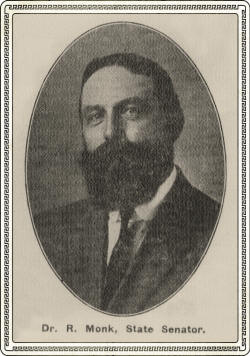
Monk Dr. R., Physician
Neillsville Brewing Co.
Neillsville Canning Co.
Neillsville Electric Co.
Neillsville Milling Co., J. L. Klockner.
Neillsville Overall Mfg. Co.
Nelson, P. N., Jeweler.
Neverman, J. L., Grocer.
Paulson, Peter, Garage. [Advertisement]
Phillips James, Real Estate. [Advertisement]
Pine Valley Creamery Co.
Pinney, Rev., S. B., Clergyman.
Pleasant Ridge Creamery Co.
Pulz, Henry, Saloon.
Rabenstein, Carl, Publisher.
Radke Adolph, F., Hardware.
Randall J. A., Implements.
Reinhard, F. L. Butter and Cheese.
Reitz, Fred, Tailor.
Ruddock, L. D., Blacksmith.
Rude, George, Soda Water.
Schaefer, G. T., Tailor.
Scherer Bros., Laundry.
Schmidt, Rev. J. C., Clergyman.
Schoengarth, August, Brick Mnfr.
Schoenherr, Theo. L. Shoemaker.
Schroeder, F., Shoemaker.
Schultz, Wm., Saloon.
Schuster & Campman, Attorneys and Abstracters. [Advertisement] [History]
Schweinler, Dr. F. W., Veterinarian.
Seidelman, H. C., Saloon.
Self & Stelloh, Implements.
Sniteman, C. C. Co., Drugs [Advertisement]
Stevens, Chas., Saw Mill.
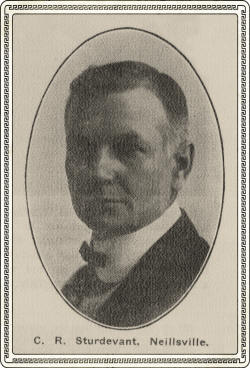
Sturdevant, J. R. and C. R., Attorneys
Tourigny, D., Hardware.
Thoma, W. C. Co., Road Commissioner.
Unger, A., Shoes. [Advertisement]
Wasserburger, Chas., General Store.
Weber, Rev. Peter F., Clergyman.
Weeks, Dr. F. T., Dentist.
Williamson, L., Publisher.
Wis.-Minn. Light & Power Co.
Woelffer, Victor C., Drugs.
Wolff, John & Co., Meats.
Zimmerman, J. G. & Sons Co., Dept. Store [Advertisement]
OWEN, A Lusty Little Village

DEVELOPED FROM A WILDERNESS INTO A THRIVING MART IN A DECADE
Owen is a young village but a lusty youngster. Its history is for the most part in the future, but it is a glorious history for all that. There is absolutely no question but that with the assured activities of the saw mill and box factory for the next twenty years or more and other enterprises in the village and the wonderful wealth of agricultural country in a section of two or three hundred square miles of which Owen is the center, and the fact that it is the junction of the Duluth and the St. Paul divisions of the Soo Line and the northern terminal of the Fairchild and Northeastern railroad, there is absolutely no question but that the future of Owen is one of continuous prosperity.
Owen was named after the family of that name which first as a part of the Rust-Owen Lumber Company, and later as the J. S. Owen Lbr. Co. have operated extensively as loggers and lumbermen throughout the west and in Wisconsin. The old Wisconsin Central, now the Soo line, was pushed through to Ashland in 1881 but for years after that there was no station or any special sign of human enterprise at the place where Owen now is. Withee was a thriving town a few miles away. The mill was started at its present site in 1893, an outfit known as the Spaulding outfit being brought from a camp on Black river ten or twelve miles distant. The site was selected on account of the wealth of timber, the Popple river, the unusual favorable lay of the land and the extremely fertile soil, the intention of the promoters being not only to strip the timber from the ground and leave nothing but piles of slashings as a menace to the future, as the early loggers had done a generation before, but rather to cut what they could use each season, and bring in settlers to clear this newly cutover land and develop fertile farms where the timber had stood only a few years ago. And in this they have been very successful, an average of 200 families a year locating around Owen and taking up small tracts to make farms. They are a hardworking, thrifty lot and the success with which they change the aspect of the country from that of a stumpy wilderness to that of stunning farms and the evidence of prosperity which comes almost immediately after they start in, is a revelation even to those who know this country best.
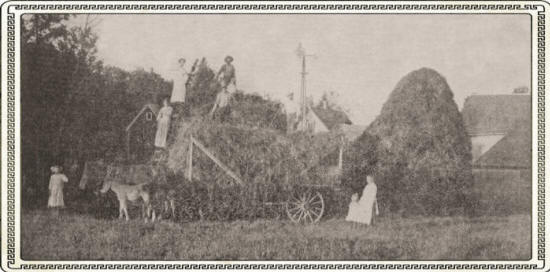
Knudt Jensen's Farm, Town of Withee.
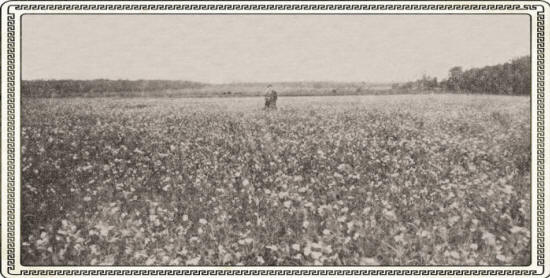
Pea Field of William Messing, Town of Withee.
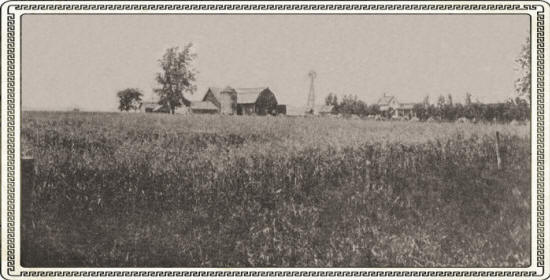
P. Sorensen's Farm, Town of Withee.
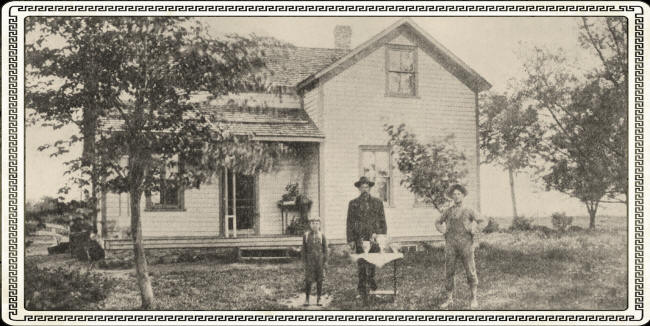
Home of John Blunk, Corn King, Near Owen.
Thee village plat of Owen was laid out by C. A. Stockwell in 1905 and the village was incorporated almost immediately afterwards. The Fairchild and Northeastern railroad came through from the southwest to connect with the Soo at Owen in 1907. There has been a steady and conservative growth, the demand for houses always exceeding the supply although the company and private individuals have kept busy building ever since the town was started. The population at the present time is about 1000. The village has an electric light plant and water works and a sewer system. Besides the saw mill and box factory which employ about 300 men, there is a large pea canning factory, with a capacity of 30,000 cases, a potato warehouse and elevator and feed mill, four hotels, four general stores, a bakery, butcher shop, tailor shop, jewelry store, three barber shops. There is a thriving bank, and a newspaper, 2 hardware stores, five saloons, a Danish Protestant church, Congregational and Episcopal churches, a shoe store and harness shop, three doctors, one moving picture theatre, a bottling works, and a local telephone company.
There is a Commercial Club in the village which is active in advancing the interests of the community. G. D. Richards is the president; A. H. Mohr, secretary; and A. G. Johnson, treasurer. The officers of the village are J. P. Anderson, president; H. C. Madsen, D. H. Richardson, William Sutter, W. G. Royer, A. H. Knight and Oscar Griebenow, aldermen. L. B. Chabot is village treasurer and O. D. Richards clerk. One of the industries to which Owen is looking forward is a condensery.
The officers of the John S. Owen Lumber Company are John S. Owen president and treasurer; Aloney R. Owen, vice president and manager; Edward A. Owen, second vice pres.; John G. Owen, secretary; Gunder E. Anderson, assistant secretary and treasurer.
Owen has probably without doubt the best hotel in Wisconsin for a town of its size—the Woodland — owned by the Owen company.
Business Directory
Abler, P. J., General Store.
Andersen, N. J., Blacksmith.
Beck, Peter, Livery.
Branstad, A. J., Restaurant.
Carter, Mrs. Edw., Restaurant.
Cherrette, M. J., Grocer.
Cichoski, Anton, Shoes.
Crane, E. J., Flour, Feed, etc.
Dilling, Miss M. R., Millinery.
Elliott, Joseph, Saloon.
Falk, Aug. F., Hardware.
Fleischman, J. B., Meats.
Gelhaar, Ed., Grocer.
Griffin Pharmacy.
International Canning Machinery Co.
Juvafi, J. L., Tailor.
Krom, Louis, Clothing and Dry Goods.
Merriman, V. D., Restaurant and Confectionery.
Miller, Mike, Saloon.
O’Neill, C. A., Saloon.
Owen Auto Co.
Owen Bottling Works.
Owen Box and Crating Co.
Owen, John S., Lumber Co. [Advetisement]
Owen Potato Co.
Owen Shoe Store.
Owen Telephone Co.
Potter, Mrs. H. Restaurant.
Rapponen, Matt., Gen. Store.
Rasmussen, N. P., Saloon.
Rawson & Griebenow Co., Hardware and Furniture.
Richardson, D. R. Gen. Store.
Schmocher, John, Hotel.
State Bank of Owen.
Sturgeon G. I., Saloon.
Vandruil, E. J., Canning Co.
Westgaard Bros., Bakery.
THE VILLAGE OF CHILI
The village of Chili was started when the Omaha road was built in 1890. Before that time the principal settlers in around there were Ira and Sydney Fike who came from Michigan a generation or so before and were logging for a Necedah firm. Whiston Davis was also one of the early settlers. P. N. Christenson operated a saw mill there for many years. Since the village plat was laid out, It has had a steady and sure growth until now it is a settlement of about 200 inhabitants and has a bank, a farmers cooperative Produce company, two general stores, a hardware store, cheese factory, garage, harness shop, meat market and potato warehouse. A year or so ago, Chili occupied a front page position in the news papers on account of a bold robbery in mid day, a stranger dropping off the afternoon train, entered the bank, held a gun to the cashier and made away with several thousand dollars and not a trace of him was found, although the alarm was sounded and hundreds of men searched every nook and corner for miles around for several days.
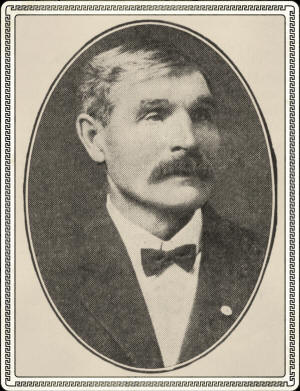
August F. Dankemeyer, Chili.
Business Directory
Chili Co-operative Produce Co.
Chili State Bank. [Advertisement]
Degener, H., Hardware.
Eide, Harry, Cheese Factory.
Hogenson, A., General Store.
Ives, Geo. S., Garage.
Reichert, L. A., General Store.
Singer, A. J., Harness.
Voelker, William, Meats.
Voight Charles, Cheese Factory.
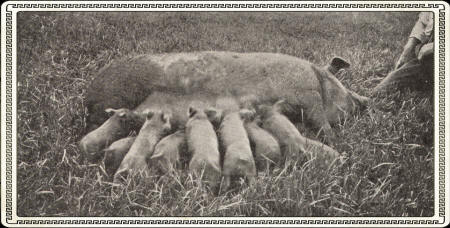
Supper Time
Pure Bred Shorthorns of F. T. Lee, Town of Fremont.
The Village of Lynn
George Ure and Gottlieb Sternitzky were the founders of the town of Lynn and the little village of the same name. Mr. Ure is the father of the present Clerk of the Circuit Court and secretary of the Lynn Mutual Fire Insurance Co. and Lynn Mutual Tornado Insurance Company and Mr. Sternitzky was the father of Henry, Charles, Ernest, James Sternitzky, all prominent Clark County residents. The two pioneers came from Chicago in 1855, Mr. Ure paying $300 for an eighty which he never saw, but which turned out to he a first class piece of land, now worth thirty or forty times the cost price, They drove through from Sparta with a team. Bartemus Brooks and sons Alonso, Dan and Erwin were also among the first comers, and Archibald Yorkston arrived shortly after, and Frederick Yankee with his sons August, William, Herman and Henry, all of whom are well known Clark County residents today.
In the old days it was the custom for all the settlers to club together and go to Sparta for flour, once a year. One year Mr. Hoover was so sick that he could not accompany the caravan and when they returned they found him without flour in the house. He dickered with a neighbor for a barrel of flour in exchange for forty acres of land, on which later over a million feet of pine timber was cut by W. T. Price.
Lynn is a station on the branch line of the Chicago, Milwaukee and St. Paul railroad up from Babcock where it connects with the main line. This line crosses the Omaha railroad a half mile from Lynn. The two roads were built at the same time and there was a sharp clash when the construction crews met at the junction. The Omaha was pushing through from Neillsville to Marshfield and the St. Paul had dreams of a through line to the Superior country. The St. Paul got to the crossing first and chained an engine to the tracks and had a carload of armed men guard the right of way and for several days excitement ran high although it subsided without any physical violence.. The Wisconsin Central pushed through a line to Ashland about the same time and the St. Paul never completed its line, but the prompt work of the contractors in those early days gave It the right of way at the junction although it runs only three or four trains a week while the Omaha has several through trains daily.
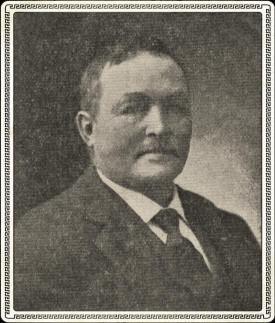
Joseph Rondorf, Town of York.
GREENWOOD
“The Hub of Clark County”
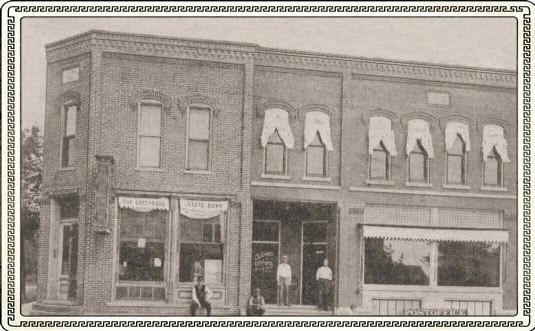
Bank Building and Post Office at Greenwood, Wisconsin.
Beautiful City on Main Highway and Where two Railroads Meet
Nothing could be prettier, nothing more satisfying either to the cold calculating eye of the practical man of affairs or the poetic sense of the beautiful in the aesthetic, than the little, city of Greenwood on the banks of Popple (actually Black) river in the undulating country to the north and south, its water tower showing for miles around as the traveler comes in over the hard smooth auto roads through the most magnificent country. Greenwood is an appropriate and beautiful name.. It is nearly in the center of the county, 17 miles north of Neillsville.
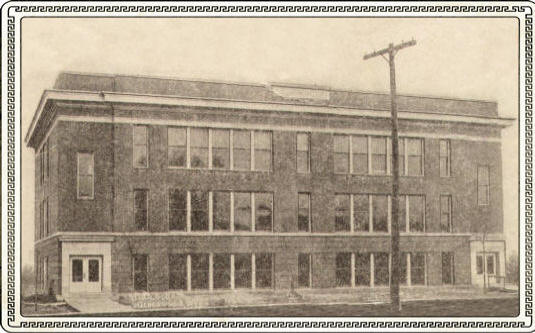
Greenwood High School.
This was the second city to emerge from the forest when the white settlers first came to Clark County. Straight up the river the march of civilization came. In 1854 Elijah and Frederick Eaton, after whom the town of Eaton is named, arrived to conquer the wilderness and on June 10, 1857. Charles W. Carpenter came through from Neillsville, and built a home, took up a large tract which he later in 1859 sold to S. C. Honeywell, the Andrews residence now occupied by the Kolden family. Robert Schofield also was one of the pioneers in this settlement, he having come in 1855.
The first store was started in 1870, operated by Chandler and Brown who came from Black River Falls.. It was at the place now occupied by Aarons brothers.
The name of Greenwood was given by Miss Mary Honeywell, now Mrs. Smith Honeywell; and was surveyed and platted in June 1871 when there were five houses and one store in the place. Charles Hogue, Oscar Nutting and Frank Brown did this work.
Homer M. Root who is still one of the prominent citizens of Clark County came to Greenwood in 1871 from Chenango county, New York, and started his successful operations which in after years has made him so prosperous. Old timers recall the year 1872—73 as the Epizoodic winter when the natives suffered hard times and from disease and were thoroughly discouraged. They also recall the “Al Brown winter”, 1877— 78, when a $75,000 failure and a mud winter combined to depress the country financially and physically.
The season of 1871 was a tremendous logging year, it being estimated that 350 million feet of timber went down Black river in the spring following the winter’s operations in the woods that year. It was only two or three years later that the pineries were practically denuded, and the record of Black river’s logging days closed. It is said that 800 billion feet of timber was sent down the Black river from 1844 when the first settlers came to 1873, which was about the last year of the drives, enough timber to make 121,000 miles of sixteen foot lumber, five times around the earth.
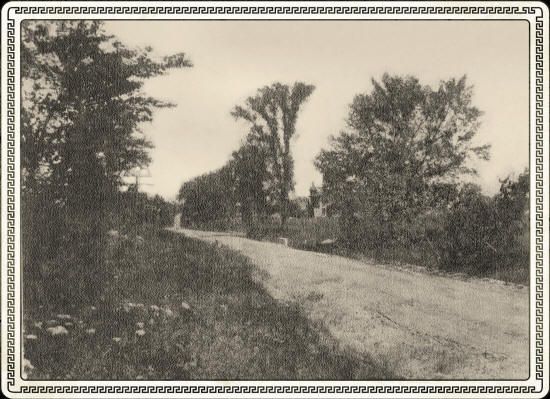
On the Road to Greenwood.
Stretch of New State Aid Road, Just South of Hoseley's Corners.
In 1900 Kippenhan & Palms started a heading mill but it was destroyed by fire in 1904 with a loss of from $10,000 to $15,000.
Greenwood was incorporated in l890. The Wisconsin Central, now the Soo line, came through from Marshfield in 1891, and the Fairchild and Northeastern came through from Fairchild on the C. & N. W. line in 1895. Greenwood with Owen has the distinction of having two railroads, the only towns in the county which can make that boast. It has a commercial organization, the Farmers and Citizens club, which is ever on the alert to promote the interests of the city, and owns its electric light plant and water plant and gives a 24 hour service. The mayor at present is Ed. Buker; Supervisor H. F. Stabnow; treasurer A. White; city clerk A. H. Schwartz (actually Schwarze); city attorney W. J. Rush; Aldermen, E. F. Wollenberg, Frank Zetsche, H. M. Pratt and E. N. Paul. There are two banks, five general stores, two blacksmith shops, two hardware stores, one department store, two meat markets, 2 millinery stores, 2 restaurants, an automobile garage, a drug store, newspaper, local telephone company, three implement dealers, a photographer, a furniture store and undertaking establishment, three hotels, three real estate offices, a planing mill, a flour mill of 100 barrel capacity, a feed mill, a lumber yard, three doctors, one dentist and one veterinary. There are Methodist, Baptist, German Lutheran, Norwegian Lutheran, German Reformed, and Catholic churches. There is a prosperous co-operative creamery and the local organization of the American Society of Equity buys stock regularly. The population at present is about 800.
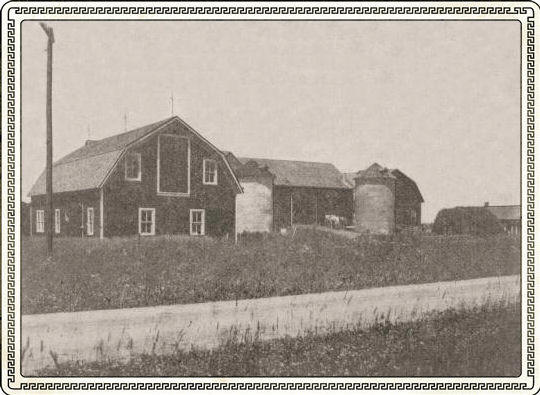
Barns of the Imig Brothers.
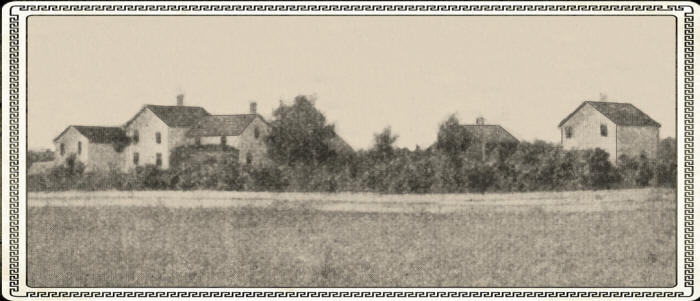
Bright Farm, Near Greenwood.
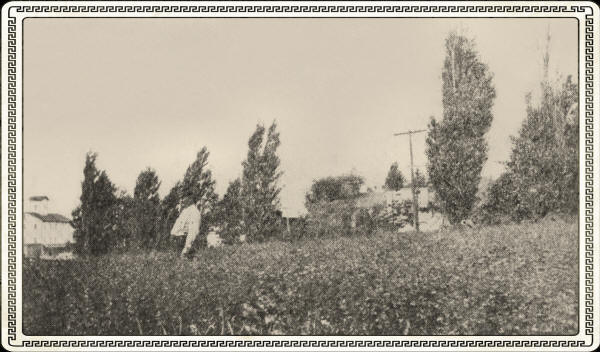
Alfalfa Field on John Bryden Farm Near Greenwood.
Following is a List of Greenwood Businessmen:
Arbs & Buker, Garage.
Arends Bros., Dry Goods, Groceries
Arms, O. H., Garage.
Armstrong, Al., Livery.
Barr, A. C. Blacksmith.
Behringer, Rudolph, Cheese Factory.
Beyer, Arnold, Cheese Factory.
Bishop, George, Furniture and Undertaking.
Black River Telephone Co.
Bryden, John, Hotel.
Carter, Mrs. N. J., Millinery.
Catlin, Mrs. A. G., Confectionery.
Clute, V. J. Mfr. Concrete blocks.
Diel, Julius, Livery.
Farmers Co-operative Supply Co.
Farmers & Merchants Bank.
Fisher, Arthur, Confectionery.
Greenwood Co-operative Mercantile and Shipping Co.
Greenwood Garage.
Greenwood Roller Mills.
Greenwood State Bank. [Advertisement]
Gullard, P. W., Drugs.
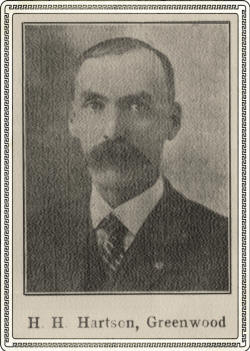
Hartson, H.H. & Son, Publishers.
Hoehne, C. C., Hardware Co.
Howard, W. R. & Son, Hotel.
Johnson, Henry, Confectionery.
Klinke Bros., Implements.
Krokson. Axel, Saloon.
Leach, Tom, Meats.
Masters, R. A., Saloon.
Noetzel, A. H., Gen. Store.
Oelig, F. H., General Store.
Prellwitz, Otto A. & Co., Flour and Feed.
Sheets. Mrs. E. K., Millinery.
Schwarze, Alb., Blacksmith.
Stalon, John, Meats.
Volk, Jacob & Bro., Tailors.
Warner H., Restaurant.
Wescott, H. A., Saloon.
White, A. M., Hardware.
Wuethrich, John, Creamery.
The Village of Loyal
A Spotless Town
Active Market for Rich Farming Communities on Every Side
Loyal to Clark County, Loyal to the State of Wisconsin, Loyal to the United States of America, Loyal to God Almighty,—Loyal.
That is the name of a village which more nearly approaches the Spotless Town of fame and fiction than any other place your wayfaring man will come across in many a day. In the center of a level stretch of the most fertile lands in the country, with evidences of prosperity and enterprise and civic pride plainly showing on every hand, this town of 1,000 inhabitants is located on a branch of the Soo line from Marshfield to Greenwood, in the central eastern portion of the county.
It was in the spring of 1886 (I think more likely 1866), on the 18th day of May, that the first settler came into that section of Clark County. He was John Graves and he came from Iron Ridge, Dodge County, Wisconsin. He had been up the fall before and built a log house in. the forest, and after winter passed drove his family up by team and located in section 16, having bought a school section. He put in a little mill and for three or four years was the only white man in those parts. His son S. D. Graves started a store about 1870 at the place where the Allen building now stands. Gradually the country settled up and a road was pushed through to the tote road from Neillsville to Greenwood and easy communication with the outside world established. It was in 1885 that the village plat was made by “Bill” Welsh and the village was incorporated in 1893 with a population at that time of 500 or 600 people. The 300 line pushed through its branch in 1889 after the C. M. & St. P. railroad had made a survey and started plans to extend its branch from Babcock through to Chippewa Falls. The 800, or Wisconsin Central, as it was at that time, got in ahead of the rival road, and as a result the St. P. branch has never come up any further than Ramadka, six miles south of Loyal, thus depriving that place of the advantages of two roads to which it is really entitled.
Notwithstanding this handicap, however, the city has gone ahead, steadily building up a sure prosperity upon the trade with the wealthy farmers. There is a good high school and grade school, Catholic and German Lutheran parochial schools, the start of a library, a heading factory, which replaces the mill which was operated for twenty five years or more with a capacity of 40,000 a day, three general stores, three confectioneries, one of which has a jewelry store in connection, 2 milliners, two blacksmith shops, 2 banks, two hardware stores, a drug store, Catholic, Lutheran and Methodist churches, a lawyer, 3 doctors and a dentist and a newspaper. B. Christman is president of the village, Albert Davel, treasurer, and T. C. Trirud, clerk.
It is the proud boast of Loyal that it does more business than any other town of its size in Wisconsin. It received its name because its founders were loyal to the union at the time of the civil war, a number of soldiers returned from the war being instrumental in organizing the new settlement. A. A. Graves, a son of the first settler, is one of the prosperous and prominent residents of Loyal at present.
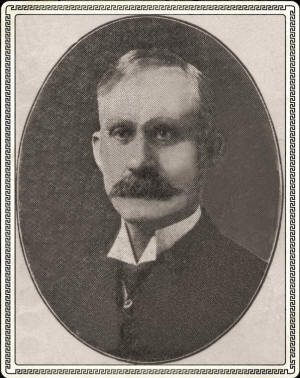
Business Directory
Bauer, John, Saloon.
Braun, Andrew, Saloon.
Chamberlain, L. B., Grocer, Jewelry and Confectionery.
Christman, B., Heading and Staves.
Colby, B. W., General Store.
Davel, Albert, General Store.
Davel, Mrs. C., Millinery.
Davel, Joseph, Harness.
Etta, J. H. & Son, Flour and Feed.
Fauss, Walter, Hardware.
Gieger, John, Shoemaker.
Graves, A. A., Heading and staves.
Hall, Chas. H., Stock Buyer.
Hindeman, M. N., Photographer.
Horn, C., Pharmacy.
Jenks Creamery Co.
Joelink, Jos., Meats.
Joss, Christ., Cheese Factory.
Jung, Gus., Furniture.
Kalbskopf, Grocer.
Loyal Lumber Co.
Loyal State Bank. [Advertisement]
McGonigal, James & Son, Hardware.
Magadanz, H. F., Cheese Factory.
Mathew, Mrs. C., Millinery.
Muckerheid, J. M. Saloon
Neuenfeldt, Wm. D., Publisher.
Peickard, J. F., Confectionery.
Philpot, J. M., Contractor.
Picus, Ben, Gen. Store.
Pitkin, I. B., Blacksmith.
Rahm Bros. & Kunde, Hay, Grain and Wood.
Schuld, Edw., Saloon.
Schuld, Peter & Son, Saloon.
Shock, George, Meats.
Steuerwald, Fred, Implements.
Taylor, C. M. Co., Furniture.
Voigt Bros., Hotel
Wedel, J. Saloon.
Wichman, Wm. Saloon.
Wiric, John, Gen. Store.
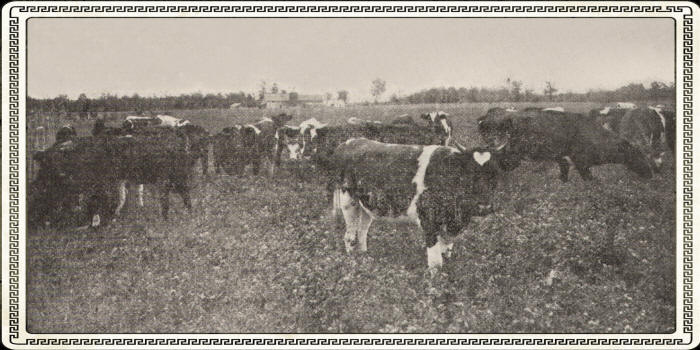
Nicholas Vader's (Vater?) Cattle in Clover.
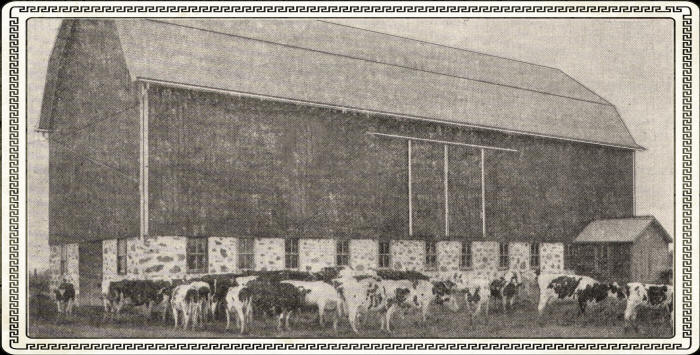
C. B. Esselman's Pure Bred Holsteins, Town of Loyal
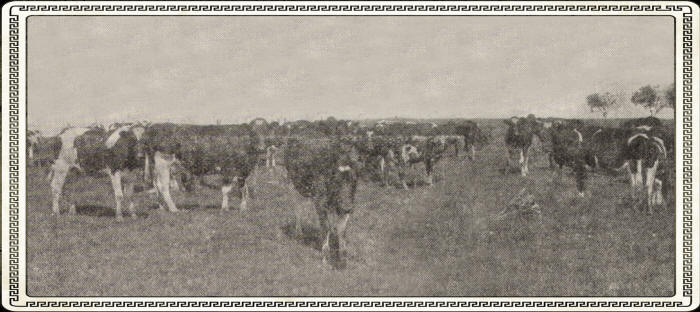
George Habbegger's (Habhegger) Blooded Stock, Town of Loyal
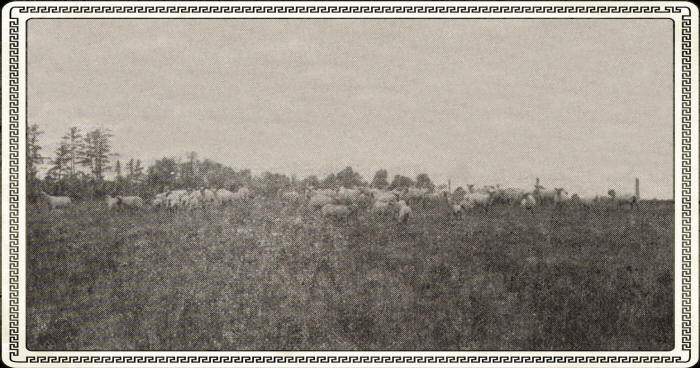
Flock of Sheep on George Tucker's Farm, Town of Loyal.
Village of Granton
A Little Town that Does Big Things
Long Stretches of Rich Farms in Every Direction
For a small town, Granton is one of the biggest places in the universe. It may be small in size and population, hut there is no limit to Its hopes and its ambitions, and there are huge dimensions to the things it has already accomplished.
On the banks of O’Neill creek, on the main line of the Omaha railroad between Chicago and Minneapolis, nestled in between gentle hills on either side, it is as pretty a little village as one wants to see. it is between Neillsville and Marshfield, the metropolis of an adjoining county, and has two hotels, a bank, three general stores, a drug store, a furniture store, a harness shop, a cheese factory, a heading mill, a Methodist church and two German Lutheran churches close to town, two automobile garages and a repair shop, three hardware stores, two doctors, one dentist, a livery barn, feed mill and elevator, a lumber yard and an opera house.
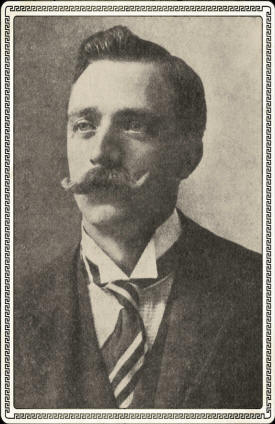
Edward Schroeder.
Postmaster at Granton and firm Believer that it is the "Best Little Town in the Best County in the Whole World!"
And there is the Granton News, the best equipped newspaper office in any town of its size in the world.
Eli Williams was the first settler in around where Granton is now situated. He came from Pennsylvania in 1856 and his descendants are still living where he located. J. D. Wage was the next comer, also from Pennsylvania, and then Levi Marsh, all of whom took up war claims, of 80 or 160 acres each, and in 1857 came Nelson Marsh with his family from the east and the following year Sylvester (Vet) Marsh from heaven, the first white child born in that part of the county. He was the Son of Nelson Marsh, who the year before had come through by way of Sparta with ox team cutting a road through the trackless forest. Gotlieb Garbisch came soon afterwards, the ancestor of several families of that name still prominent in the community.
Nelson Marsh located about a quarter mile east of the present site of Granton and established a farm and tavern and stopping place on the aid stage route from Neillsville to Stevens Point which was established in 1858. There was a post office in his house, Mapleworks by name, although it should have been Maplewoods, the chirography of the early settlers being deciphered wrong by the postal authorities at Washington. The stage route was maintained until the railroad came through in 1891 and on the old maps of the county Mapleworks is one of the two or three places marked in Clark County.
The 60 acre farm which is now the village site of Granton belonged to T. D. Wage and when the railroad wanted a tract for a depot, his terms were such as to make the railroad people think them unreasonable, and plans were made to build the depot half a mile further east. Vet Marsh and some others remonstrated with Wage and finally bought his sixty acres, induced the road to come back and build the depot where it now is, and platted the village which has grown and prospered ever since.
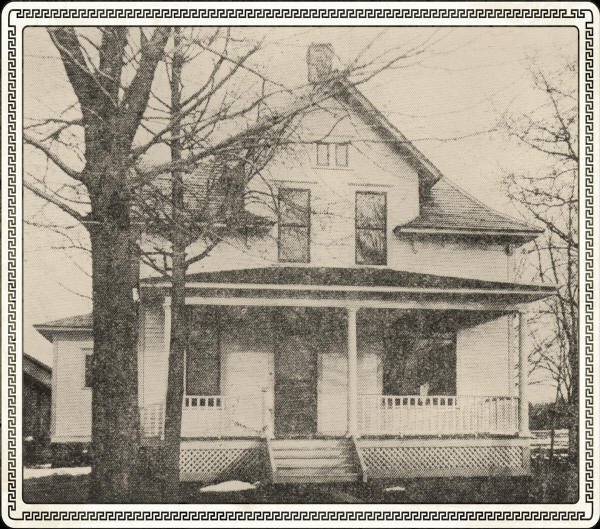
The Home of Sylvester L. "Vet" Marsh.
Charles Cornelius, now one of the leading bankers in the county, came to Mapleworks in 1875 from Sheboygan county and bought the store which had been started by Fred Walker of Plainfield three years before, and ran it until he was elected register of deeds in 1885 and started the successful career which has made him a commanding figure in Clark County history.
Congressman W. T. Price, an old character and one of whom old timers tell many interesting anecdotes, was the principal logger in the early days, although John Paul later was quite widely known as an operator.
D. Barker built the first store in the village proper soon after it was platted, the store now occupied by P. J. Kemmeter. Several buildings were moved from Mapleworks to the new town site. W. H. Butler and H. A. Knorr, the latter still a resident of the village, built the store building now occupied by the Witte Cash store. John Trimberger built the first structure in the village on the site of the Eagle Hotel.
The Business Men’s Association of Granton organized a few months ago has given the world an example of community co-operation and enterprise in buying, maintaining and operating a moving picture show. The opera house was rented for a year and shows put on twice a week to which the farmers are invited, it has been a profitable venture and whenever any surplus results, free shows or high class shows at moderate prices, will be given, the business men disclaiming any idea of running the show for profit. They have installed an electric lighting plant and bought a picture machine and get the best reels twice weekly from the Chicago exchanges.
The officers of the Business Men’s club are P. J. Kemmeter, president; H. C. Witte, vice-president; Albert Jahr, treasurer; G. E. Amidon, secretary. There are about forty members including practically every merchant in the town.
The heading and stave mill is an institution which has continued year after year and promises to continue indefinitely. It has a capacity of about 1000 cords of bolts each season and is a great help to the farmers in the vicinity in providing profitable work during the dull winter months. It runs a day and night shift of ten or twelve men each, it has been run continuously for 22 years, which is probably a record for a plant of that sort.
The Farmers State Bank probably does the biggest business of any bank in the state with a capital stock of $10,000. The deposits range from $175,000 to $200,000 and the business done for the wealthy farmers in the vicinity would put to shame many an institution which is more pretentious in the larger cities.
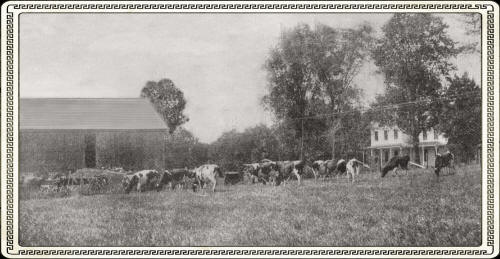
Farm of H. O. Huckstead, Town of Grant.
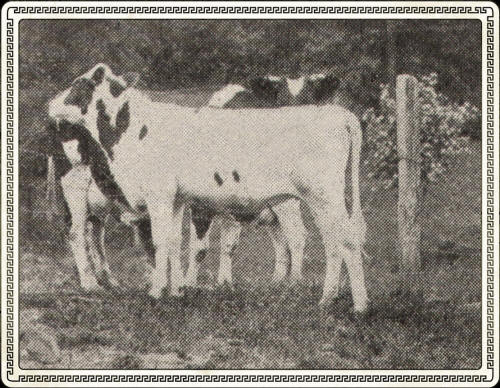
Some of Louis Emil Reinhold Moh's Pure Breds.
Residence on the Winfield Scott Davis Farm, Granton.
Amidon's Drug Store, Granton.
Business Directory
Amidon, C. B.. Drugs. [Advertisement]
Baer, F. J., Publisher.
Beaver, George, Saloon.
Bergeman, Gust. H., Hotel.
Badl, J. H., Harness.
Connor, R. Co., Lumber Yard.
Davis H. F., Hardware.
Farmers State Bank. [Advertisement]
Finnigan, .James, Blacksmith.
Finnigan, Chester, Garage.
Grassman Henry, Blacksmith.
Hammler Bros.., Furniture.
Jahr Bros., General Store.
Kemmeter P. J., General Store & Heading Mill.
Knorr & Rausch, Garage.
Knickle E. H., Garage. [Advertisement]
Lautenbach, August, Hardware.
Peterson, O. A., Cheese Factory
Rahm Bros. & Winn, Feed Store.
Reichert, Alvin, Photographer.
Reichert, F. W., Jeweler.
Rath, H. H., Physician.
Ross, P. M., Physician.
Rose, H. L., Dentist.
Rose, George J., Livery
Storm, William, Saloon.
Hart, Fred, Meats.
Thayer, . J.. Hardware.
Wagner, Herman, Saloon.
Witte, H. C., General Store.
UNITY
Unity is the paradoxical name of a town divided by a county line, half of it being in Clark and half in Marathon, the result of the fact that the old Wisconsin Central railroad chose the county line for its right of way. Unity iS on a hard- wood ridge the highest point of land between Medford and Stevens Point, and is surrounded by the best farming land to be found anywhere. It is a town of about 400 population and has a sawmill, three general stores, drug store, millinery store, blacksmith, wagon factory, harness shop, grain and fuel store, furniture store, garage, two hardware stores, a bank, a produce company and two telephone lines.
Business Directory
Clark, J. H., Drugs.
Creed, Wm., Gen. Store.
Duvall Chas., Saw Mill.
Glaman, Wm., Saloon.
Groelle & Haman, Gen. Store.
Harvey, Miss J. B., Millinery,
Jarvis, J. L., Blacksmith.
Johnson, J. P., Wagon Manfr.
Klein Phillip, Shoemaker & Harness.
Koch, J. F., Hay, Grain and Fuel.
Kuehnan, J. H., Furniture.
Laabs, Wm., Saloon.
Mattison, M. S., Garage.
Messer, L. E., Printer and Notions.
Morgan, W. E., Hardware.
Olson, Peter, Saloon.
Perschke & Cutts, Hardware.
Rohde, Otto G., Mnfr. Cheese.
Simon, Fred, Hotel.
Smith, Ed., Mnfr. Cheese & Butter.
Unity Eastern Telephone Co.
Unity Mercantile Co., Gen. Store.
Unity Produce Co.
Unity State Bank.
Unity & Southwestern Telephone Co.
Vogt, C. & Son, Implements.
Weyers, L. H., Gen. Store.
Weide, August, Meats.
Neillsville Canning Company
The Neillsville Canning Company was organized on Feb. 15, 1913, with a capital stock of $15,000 after several meetings of the businessmen of the county seat. Robert Kurth was chosen president, Gust. Krause vice-president, George Ure treasurer, and Levy Williamson, secretary, all of whom have served in their respective positions since. In the spring of the same year a plant was erected near the railroad depot at Neillsville, convenient for the farmers bringing in their produce arid with side track facilities for shipping the goods. It is a well built structure and a valuable addition to the industries of the city, employing half a hundred hands or so during the packing season and making a ready and profitable market for the products of scores of acres in the vicinity.
During the first season about ten acres of beets and beans were planted by the company and about 20 acres by the individual farmers and 5000 cases of canned products were manufactured and shipped. During 1914 there were 75 acres devoted to raising crops for the factory and 18,000 cases were manufactured. During the first year the financial status of the concern was satisfactory but not tremendously so, but after the close of business for the second year the stockholders carried very satisfied expressions and it was reported that the season had been eminently successful.
This year there are 125 acres of beans and about 400 acres of corn being cultivated for the factory and the output will be proportionately increased, probably 40,000 cases. Additions and improvements have been made to the plant so that it is now absolutely up-to-date in every respect and operated according to the most approved sanitary methods, the work of canning the product being done entirely automatically by the machinery, no human hand touching the foodstuff from the time it is brought to the plant until it is hermetically sealed in the cans. Of the output this year it is expected that about one half will be beans and nearly as mush corn, with beets, pumpkins and kraut in smaller quantities but all under the same brands, the well and favorably known “Marathon” and “Big Farm” brands. These brands have enviable reputations with the trade and find a ready market.
The canning factory is expected to be the start of a number of industries which will add to the prosperity of the county seat. During its comparatively short existence it has paid out about $35,000 in wages and for crops and some of the farmers who have given their attention to the crops especially for the factory have profited to the extent of $200 an acre by so doing.
When you eat canned corn or beans, get the “Marathon” or “Big Farm” brand.
The Village of Thorp
Market Place for Sturdy Settlers
Two Great Catholic Churches Supported by Wealth from Farms
Thorp is a village in the northwestern corner of the county, on the Soo line and is known throughout the county as the center of one of the most thriving and prosperous Polish colonies in the United States. There are two big Catholic churches there, or rather one in the village proper and one about two miles from the village, the latter a Polish Catholic church, said to be the largest church structure in the country outside of a large city.
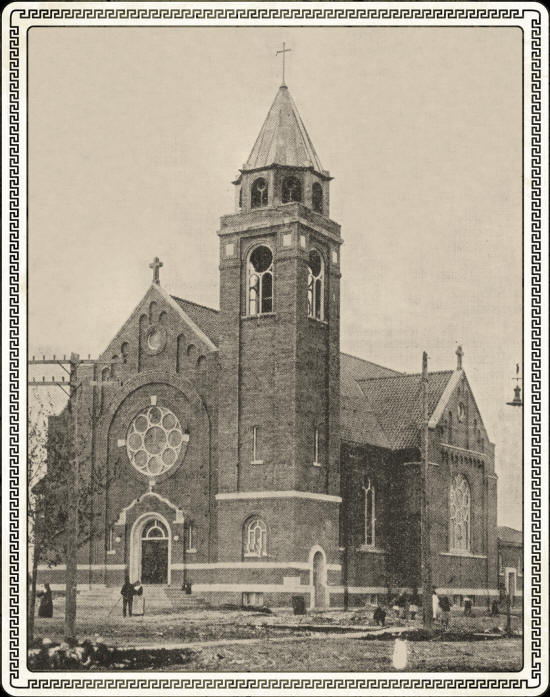
St. Bernard's Catholic Church, Thorp.
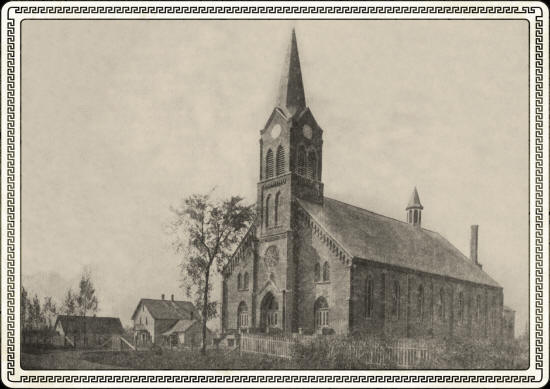
St. Hedwig's Catholic Church, Town of Withee, near Thorp.
Thorp was named after Hon. J. G. Thorp of Eau Claire Lumber Company, one of the prominent men of Wisconsin a generation ago, his daughter married Ole Bull and her father built a palatial home for them at Madison which afterwards became the executive mansion. It was the Eau Claire Lumber Company which developed this country after cutting off and removing all the timber. Mr. K. Rosolt of that company being the moving spirit for twenty five years or so in getting settlers upon the new land.
Although named Thorp, it was J. S. Boardman and his brother Ephraim A. Boardman who built up the town. They came from Rochester, Minn., about 1871 and took up 160 acres of government land, one on either side of the range line between ranges 3 and 4 west of the fourth Principal meridian, and that range line now runs through the main street of the village. J. S. Boardman disappeared from sight about twenty years ago and has never been heard from since but his brother Ephraim remained on the original quarter section and when the Soo road, or the Wisconsin Central as it was then, came through, platted his farm into lots, sold them and became the patriarch of the village until he died a few years ago, having sold out but 65 acres of his original farm, the 56 acre tract now a beautiful grove of woods north of the village.
The railroad attempted to found a town, platting out eighty acres half a mile west of the site of the present village but the Boardmans stole a march on the road and got the settlers to build on their lots. For years the depot was half a mile from the houses in town. The Nye, Lusk & Hudson Company started a saw mill in 1881 with a capacity of about 30,000 feet daily and it was largely through that fact that the town failed to start where the railroad had planned it. The mill is still running hut has about completed its work, now buying small lots from the farmers and sawing a comparatively few thousand annually. There is a stave and heading mill, however, which is a considerable concern.
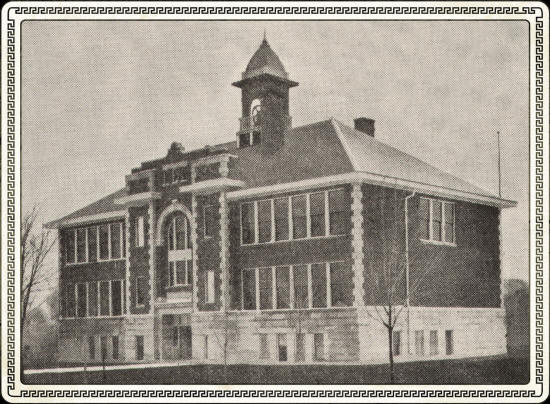
High School Building, Thorp.
But the big creamery of Thorp which pays out $125,000 a year to the farmers is the industry of which the citizens are proud. The shipments of cheese during 1914 aggregated 1,238,310 pounds of butter 384,281 pounds, of eggs 83,682 pds., and this year there will be an average of two car loads of cheese and one car load of butter weekly. Fifty silos were erected around Thorp this year.
The village owns a municipal light and water plant which has been in operation for fifteen years, has a library of 2000 volumes, public schools and a big parochial school, gets its water from artesian wells, has a sewerage system installed at a cost of $16,000 so far, has ordered all the telephone wires put under ground and prides itself on the fact that it is going to be the banner cheese and butter producing center of the world within the next generation. The present officers are W. S. Parks, mayor; E. H. Wiley, treasurer; W. E. Barrett, clerk, William Wagner, postmaster. It has a population of about 1,000.
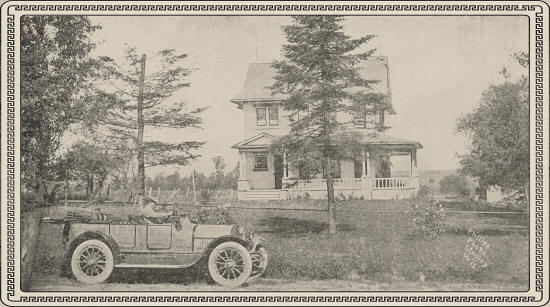
John Landry's Farm Home in Town of Thorp.
Twenty years ago he was a Camp laborer, now an Independent Farmer
Business Directory
Alberts, Chas., Confectionery.
Baldeschweiler, Alois, Sawmill.
Banderob, Herman, Harness.
Banderob, T., Millinery.
Barrett Bros., Elevator and Ward.
Becker, Mrs. Geo. F., Millinery.
Boardman, E. A. & Sons, Sawmill.
Bogumill, John G., Furniture.
Bogumill, John G. & Sons, Gen. Store.
Borowick, Peter, Saloon.
Brunner, H. J., Blacksmith.
Burkhardt, August, Box Factory.
Butterfield, C. L., Well Driller.
Colby Brothers, Feed and Planing Mill.
Connor, James, Saloon.
Dedring, Otto, Jewelry.
Dudkiewicz, Louis, Gen. Store.
Farmers Exchange Bank. [Advertisement]
Frank, Dr. W. J., Dentist.
Garrison Mercantile Co., Gen. Store.
Greisch, Matt,, Pumps and Windmills.
Gruszynski, J. F., Box Mnfr.
Hanson & Zaborowski Implement Co.
Jackey, S. D., Physician.
Klemp, F. A. Confectionary.
Kriese, Mrs. R. J., Confectionery.
Klouda, Joseph, Boot and Shoes.
Lombard Dairy Co.
Mallison, M. W., Restaurant.
McCutchceon, W. R., Physician.
Mokrzycki, John, Saloon.
Malinowski & Anyzewski, Saloon.
Morgan, Joseph, Livery.
Nolechek, Dr. W. F., Veterinarian.
Norton, James, Hotel.
Nye, Lusk & Hudson Co., Lumber.
Penana & Zuzwiak, Gen. Store.
Peoples State Bank. [Advertisement]
Phillips, L., Dry Goods and Grocery.
Piwoni Theofile, Saloon and Grocery.
Plucinski, Frank, Hardware.
Rasmussen, Julius, Saloon.
Riverside Dairy Co.
Schneider, E., Grocery and Harness.
Schroeder, A., Saloon.
Selden, W. B., Physician.
Snyder, Mrs. E. L., Gen. Store.
Solvrud, O. A., & Co., Meats.
Stookey, D. E., Real Estate.
Sikorski, Charles, Saloon.
Stracker, Miss Elsie, Millinery.
Stryk, A., Box Mnfr.
Thorp Dairy Co.
Thorp Mnfg. Co., Staves & Heading.
Thorp Mercantile Co., Gen. Store.
Wagner, H., Publisher.
Walsdorf, Aug., Mnfr. Soft Drinks.
Walsdorf & Johnson, Hardware.
Walsdorf, William, Saloon.
Wiley, E. R., Gen. Store.
Zielanis, Jos. General Store.
Zukowski, M. & Son, Gen. Store.
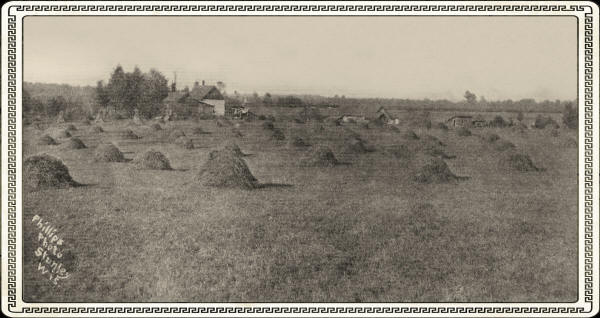
Harvesting a Second Crop of Clover on C. S. Evanson's Farm, Thorp, Wisconsin.
HEMLOCK
The little settlement of Hemlock has a history of greater proportions than its present importance, as in the early days of the county it was one of the chief trading centers and was the site of a dam, and a grist and saw null. The dam was built in 1879 at a cost of $21,000 and went out only a year or two ago as the result of unusual spring rains.
LONGWOOD
Longwood, on the old maps, occupies a position equal almost in importance to the county seat, while the now prosperous villages of Owen. Thorp and Withee are not to be found. It was a post office and important trading station in the early days, but since the advent of the rural mail carrier is serene in the history of the olden time and its assurance that the development of the surrounding country must ever be its support even if other places outstrip it in importance. At Longwood now there is a store operated by Erickson & Thorson and a cheese factory of which Henry Mathias is the proprietor. The hamlet has a population of about 50 persons.
EIDSVOLD
Eidsvold is the name of a little community of 75 or 100 people in the extreme northwest corner of the county, on the Soo line, two miles west of Thorp. Boardman Brothers operate the general store at that place.
CHRISTIE
Christie has 150 inhabitants. It is located on the old tote road between Neillsville and Greenwood and for years was an important post office in the county Frank Wheeler conducts a prosperous general store there now.
DORCHESTER
Dorchester lies between the Eau Pleine river three miles to the east and Poplar river a like distance to lie west, being on the water shed, one stream flowing into the Wisconsin river and the other being a part of the Black river system. It is on Lie Soo line and at one time was an important mill town, but in later years prospers as the center of a rich farming community. It has a population of about 600, and is one of the thrifty and progressive towns the northeastern corner of the county, two miles from one county, one and a half mile from another. The village is especially proud at present of its new grade school building, a cut of which is published herewith, erected at a cost of $12,000, 45 x 78 feet in dimensions, two story and basement.

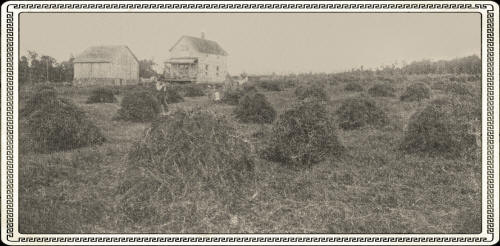
Haying time in Upper Clark County.
Business Directory
Bauernfeind, J., Blacksmith.
Bassler, George, Bakery.
Bobbe, G. A., Feed.
Buehreus, John, Tinner.
Dorchester Co-operative Co., Store
Dorchester State Bank. [Advertisement]
Esser, Albert, Saloon.
Fleckenstein, V., Hardware.
Fuchsgruber, L. & Son, Furniture.
Garbisch, Louis, Saloon.
Genrich Gust., Blacksmith.
Homsted, Aug., Drugs.
Janke, Helmuth, Cheese Factory.
Katzin, A. Dry Goods.
Knaack, Albert, Saloon.
Kronschnabl, H., Pool.
Krackenberger, Mrs. A., Hardware.
Lotzer, Paul, Flour and Feed.
Ludovic & Sullivan, Hotel.
Martin, Fred, Saloon.
Miller, Bertha, Millinery.
Miltimore & Son, Grocer.
Paulson, O., Lumber.
Peterson, W. L., Hardware.
Rogolske, Jos., Shoe Repairs.
Schmidt, Fred, Saw Mill.
Schmidt, John, Hotel.
Schreiber, Richard, Meats.
Schultz, G. N., Gen. Store.
Siegert, Andrew, Saloon.
Skruvani, L., Gen. Store.
Sprague, Geo., Gen. Store.
Tepolt, Frank, Saloon.
Ugorets, Sam., Junk.
ABBOTSFORD
Abbotsford for years was famous chiefly as the junction of the Chippewa Fans railroad with the Wisconsin Central, now both part of the Soo line. It is three miles north of Colby and since the cut-off was built from Spencer to Owen and the consequent removal of railroad activities from the former junction, the advancement of Abbotsford was not rapid for a few years, but recently it has found a new mission in supplying a local market for a rich farming country and is steadily progressing. It has a population of about 1600 and together with Colby and Unity is on the line between Clark and Marathon counties.
Business Directory
Abbotsford Electric Co.
Abbotsford Bank. [Advertisement]
Abbotsford Butter and Cheese Co.
Abbotsford Co-operative Mercantile Co.
Abbotsford Mnfg. Co., Carriers.
Banditt, Leo, Grocer.
Berry Bros., Meats.
Custom Lumber Co.
DeLap, M. W., Shoes.
Fessler, G. H., Boots and Shoes.
Fisher, J. & Son, Hardware.
Harrington, L. J., Livery.
Henk, Casper, Implement.
Hill, S. S., Confectionery.
Jackson, Walter, Mnfr. Cigars.
Laabs & Schmidt, Flour and Feed.
McAssey, George, Photographer.
Mannes, Wm., Printing.
Meyers, A. J., Gen. Store.
Olson, Mrs. H., Millinery.
Omans, B. S., Blacksmith.
Pauterbach, John Saloon.
Peterson, Nels, Machine Shop.
Schmidt, John, Saloon.
Schmidt & Pechstein, Clothing.
Schultz, Chas., Saloon.
Schultz, Wm. E., Hotel.
Stroota, Albert, Hardware.
Tabor, N. G., Pianos.
Thompson J. B., Hotel.
Treat, R. H., Jewelry.
Wells & Chase Auto Co., Garage.
Wing, F. B., Drugs.
DEWHURST & BROOKS
Dewhurst and Brooks are the names of little settlements in the town of Sherwood, in the extreme southeast corner of the county. The store at Brooks burned down recently but will be rebuilt at once.
WILLARD
A few years ago Ignatz Ceznic started to organize a colony of Slays and kindred nationalities in the wilderness in the town of Hendren. Today that country is dotted with scores of prosperous farms and the village of Willard is the market place for them, a station on the Fairchild and Northeastern railroad, with two stores conducted by Justic & Kochianchich and John Zoller, and a creamery and other enterprises. It is a thriving little place of. about 50 people. Mr. Ceznic had the backing of the Foster Lumber Co. of Fairchild in his work.
TIOGA
Tioga is a little settlement on the Fairchild & Northeastern road 20 miles northwest of Neillsville, R. D. Ingham conducts the general store and acts as postmaster and station agent.
GLOBE
Globe is an inland town ten miles north of Neillsville in the center of a prosperous farming community. It has a creamery, a large German Lutheran church and school, and a store conducted by Linus Prock.
COLBY, Cheese Champion
The Town and City which Wrested the Honors From Herkizner Co., New York
Colby is one of the thriving towns on the line between Clark a Marathon counties, dividing allegiance between them. It has a population of about 1000. Formerly the Marathon county half was called Hull and there was a lack of harmony which
prevented the best development but a village organization overcame this defect and now Colby presents a united front in the line of progress. It is near the Big Eau Pleine river one of the tributaries of the Wisconsin river and was a station on the old Wisconsin Central, now the Soo line, in the early logging days of 1873 and so was a prominent place before some of the rest of the county was known.
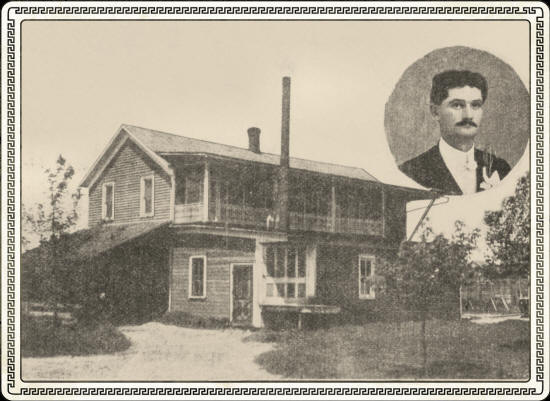
The Home of Colby Cheese.
Colby is the Cheese Champion of the world. It was Battling Nelson who gave that title to one of his rivals in the field of fisticuffs but that was in derision, while the championship which is defended by the city of Colby is an honor and a profit worthy of the best localities in the world. From Herkimer county, New York, was wrested not only the quality of output of fine cheese but the quantity too, and now Colby Cheese is demanded by the epicures everywhere.
Colby was named after Gardner Colby of Boston of the Colby-Philips Construction Company who built the railroad for the Wisconsin Central company, of which his son, Charles L. Colby, was president. It now has an electric light and water plant representing an investment of $35,000 and which has been in operation since 1903. There is a good library. The present officers James E. Lyons, mayor; John Pribnow, treasurer; R. G. Salter, clerk; Joseph Frame, assessor; H. Reeves, H. A. Krepsky, E. D. Loos, and Ben Riplinger, aldermen; H. L. Blanchard, postmaster.
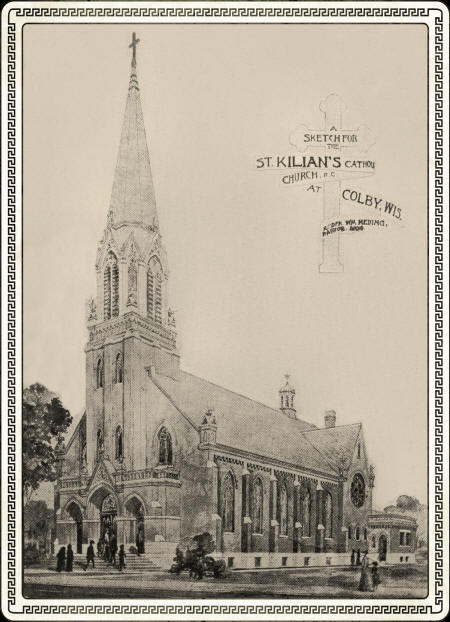
St. Kilian's Catholic Church, Colby, Wisconsin.
One of the main features of the town is Uncle Joel Shafer, who came from Beaver Dam to the then Colby in 1878, or 1788 no one can rightly tell which, and with his brother started a paper and tried to organize a new county embracing part of Clark, Marathon and Taylor counties. The movement after a sharp clash of interests subsided and left the Shafers stranded in Colby where they have run their paper, The Phonograph, ever since, until the death of Sam Shafer a number of years ago, and now run by Joel Shafer, well known and highly respected throughout the state, the patriarch of newspaper men in Central Wisconsin and the preceptor of many bright young journalists who have made their name famous throughout the world.
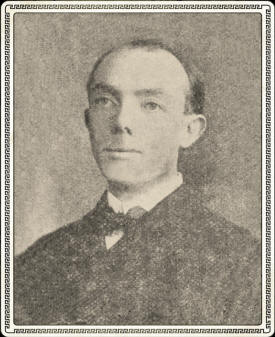
Dr. H. H. Christopherson, Colby, WI
Business Directory
Adams, Peter, Blacksmith.
Bast,, M., Soft Drinks.
Berg, Jacob, Saloon.
Bleichroth, Traugut, Jewelry.
Briggs, O. R., Drugs.
Bruss, A. W., Mnfr. Cheese.
Burkhardt, Charles, Gen. Store.
Carlton, C. B., Blacksmith.
Clark County Telephone Co.
Colby Cheese Box and Silo Co.
Colby Hardware Co.
Colby Lumber Co.
Colby State Bank. [Advertisement]
Daisy, S. B., Elec., Supplies.
Dix Brothers, Meats.
Enmam, Ray P., Jewelry.
Firnstahl, Frank, Boots and shoes.
Fleischauer, B. A., Tailor.
Fleischman, W., Gen. Store.
Frome, Charles, Saloon.
Gramhart, Miss Malina, Millinery.
Georgos, Bertha, Millinery.
Heppner, R., Meats.
Johnke, Otto, Saloon.
Johnson & Pribnow, Gen. Store.
Kautsky, E. V., Saw Mill & Lumber.
Keats Bros., Hotel.
Kobs, Albert, Saloon.
Kraus & Kersten, Gen. Store.
Loos, B. D., Machine and Boiler shop.
Lukowicz, Photographer.
Lukowicz, J. & Co., Flour and Feed.
Lulloff Bros., Furniture and Undertaking.
Lulloff, G. & Sons, Marble.
Lyons, J. B. & Co., Grain.
Michaelis, Paul, Mnfr. Cigars.
Neumeister, H., Harness and Hides.
Niggeman, C., Blacksmith.
Orth, Conrad, Saloon.
Roohr, George, Blacksmith.
Schaller, Frank, Hotel.
Schleinn & Burmeister, Saloon.
Shafer, Joel, Publisher.
Sommers, Arwin, Mnfr. Cheese.
Werner, John, Hotel.
Zillman Bros., Hardware.
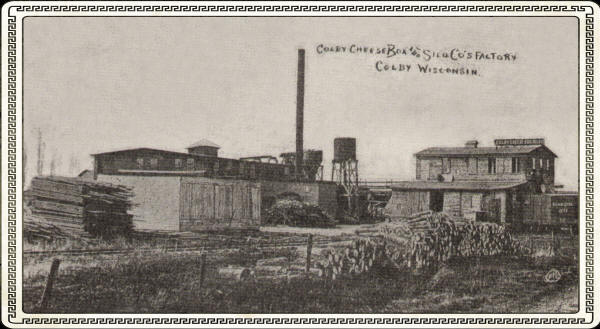
Colby Cheese Box and Silo Company Factory, Colby, Wisconsin.
CURTISS
Curtiss is a little settlement of about 350 people right in the heart of the rich dairy belt of Clark County, on the Soo line between Owen and Abbotsford. It was named by the Wisconsin Central railroad company in 1881 when the line was pushed through this part of the state. A. D. Bast and Clark started a saw mill in 1882 and moved the town from the flag station where the railroad intended it to be to the present site, half a mile away. Among the early settlers were A. B. Mathias who came from Loyal, Otto Janke from Sheboygan county, and G. H. Thayer, who with his parents came from Fond du Lac in 1887, Arne Olson, Warne Ellis and Steve Platt, now dead. The village was platted in 1883. The saw mill still does business, giving employment to 15 or 20 men for three or four months of the year, and a planing mill runs continuously. The creamery and cheese factory, however, is doing the business which the lumbermen did in former years, and is distributing good sized checks twice a month to the farmers nearby. The farmers are for the most part of German or Norwegian extraction although all are good hardworking American citizens.
Business Directory
Bloc, Charles, Gen. Store.
Boehm, Herman, Saloon.
Curtiss Produce Co.
Curtiss State Bank. [Advertisement]
Green Bros., Gen. Store.
Jones, Fred, Blacksmith.
Kluve, Aug. J., Meats.
Laabs, Albert, Saloon.
Liberty, H. A., Lumber.
Luethy, Adolph, Cheese Mnfr.
Machlett & Son, Hardware.
Meyer, Fred, Groceries.
Mueller, August, Hotel.
Peterman & Reibsamen. [Advertisement]
Ravey, C. H., Harness shop.
Schroeder, Louis, Blacksmith.
Zasoba, John, Shoemaker.
BRIGHT
Bright is a station on the Fairchild & Northeastern road five miles south of Owen, named after a wealth capitalist of Black River Falls who has a large stock farm there.
VILLAGE OF HUMBIRD
A Hustling Little Village With a Bright Future
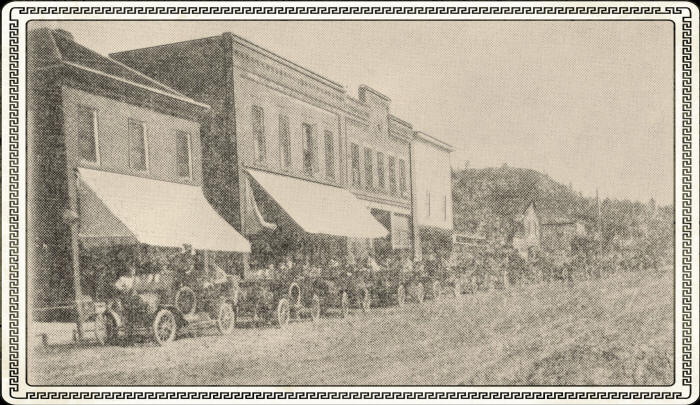
Street Scene, Humbird.
This thriving village is situated in the southwest corner of the county, prettily tucked in securely under the protection of an overhanging mound. It was named after Jacob Humbird, a railroad contractor, and laid out and platted in 1869. In 1872 the railroad which is now a part of the great Northwestern system was pushed through as far as Humbird which gave it a great deal of importance as the market place for Clark County, grain and lumber being shipped out and provisions and goods of every description being received and transported overland over the tote roads to the inland towns and, camps. It is a thriving town, surrounded by a rich and prosperous country and contains two hotels, a bank, two general stores, hardware store, blacksmith shop and implement house, millinery store, grist mill, drug store, meat market, garage, creamery, cheese factory, furniture store and undertaking establishment, livery, confectionery and so forth.
It has a population of about 600 and being on the main line of a great railway system enjoys. unusual transportation advantages.
The village has first class schools, the system being made up of High School, Graded Schools and Rural Schools, with an efficient corps of teachers. The high school is accredited to the State University. The school library has over a thousand volumes which are available for public use. A Social Center club is maintained in the village, which holds semi-monthly meetings in the high school room. P. A. Hemmy is president of the club. The community is closely connected by local and rural telephone lines.
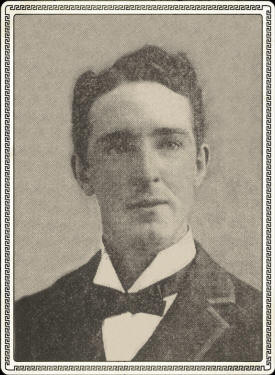
Edward T. Hale, Editor of the Humbird Enterprise
and Member of the County School Board.
Business Directory
Barkley & Washburn, Blacksmith and Implements.
Brandstedter, (Mrs. C.) Gen. Store.
Briggs, Mrs. H. M., Hotel.
Chenoweth, Ed. Grist Mill.
Bienick, Miss Carrie, Millinery.
First State Bank. [Advertisement]
Fristad, C. B., Drugs.
Hahn, J. C., Saloon and Confectionery
Hart, George, Meats.
Humbird Auto Co.
Humbird Cheese Co.
Humbird Co-Operative Creamery Co.
Humbird Roller Mills.
Kneubuehl, Jacob, Saloon.
Kretschmer, M. Furniture and Undertaker.
Laffe, George, Saloon.
Midland Lumber Co., Coal Co.
Shute, F. A., Gen. Store.
Simons, F. J., Hardware, etc.
Sparkes, H. A., Wall Paper.
Sparks, A. L., Livery.
Sparks, Mrs. L., Confectionery.
Springhook Cheese Co.
Stallard, J. B., Land Sales and Life Insurance [Advertisement] [Biography]
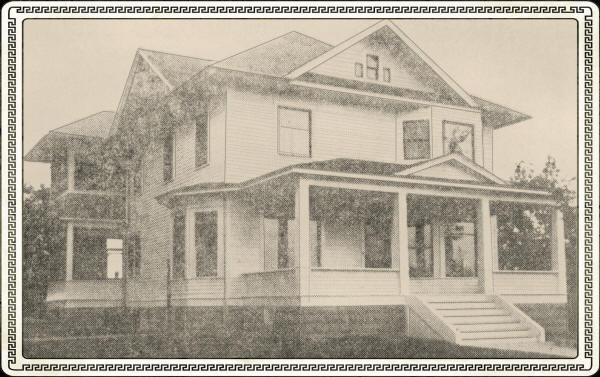
B. J. Stallard Home.
COLUMBIA
Columbia has a population of about thirty and is a station on the Omaha line between Neillsville and Merrillan. It has a good looking school building, and several nice homes. A. Schlender is the store keeper. Several years ago Columbia was boomed by a land company but the exploitation was overdone and that part of the county until recently has suffered from the after effects of too much publicity.
BANKING IN CLARK COUNTY
By CARL STANGE, Neillsville, Wis.
No other business is so closely connected with the development of a community as the banking business, and as it grows so also grows the banking business.
Money is the life, or rather the blood of business and commerce, and the banking business is like the heart in man or beast, the instrument which turns money into the proper channels where it is needed.
Money hid in an old stocking or buried in a cellar is dead to the world, just as the it were not in existence at all. Money in the banks circulates like the blood in the body, and helps to carry on the business of the world. There are people who think that banks hoard money, pile it up just for the fun of the thing, as the money piled up would make more money. No bank keep more money in it vaults and safes than is absolutely necessary to carry on business over its counter, All other money is either loaned out or deposited in some bank in one of the money centers like Chicago, Milwaukee, New York, St. Paul, Minneapolis and other cities where the same process is gone thru with as stated before, only with this difference: in the larger money centers larger amounts of cash have to be kept on hand on account of their being called upon by the country banks to supply them with needed cash. In the development of the banking business Clark County has been no exception.
When the writer of these lines entered into the banking business, over twenty-five years ago, there were only two banks In Clark County, namely: The Clark County Bank with Levi Archer as president and Win. G. Klopf cashier, and the Neillsville Bank with Richard Dewhurst president and Joseph Morley cashier, each with a capital of $25,000.00, both located in Neillsville, and if memory serves me right, their combined deposits did not amount to $250,000.00 at that time. For several years thereafter they were the only banks in this county.
At that time the main business in the county was lumbering off the timber which covered the county, putting it into the various streams where the spring freshets floated it down to La Crosse and other points along the Mississippi river, where it was cut into lumber and distributed to consumer. Most of the lumber and land was owned by capitalists outside of the county and all they cared for was the profits from the timber. The land was considered worthless and a great deal of it reverted back to the county for nonpayment of taxes.
For a long time our timber supply was thought inexhaustible but at last there could be seen the handwriting on the wall. We all began to see the end of the lumber business and soon our timber was gone.
In looking back, much as I liked the grand old woods, I am glad It is gone. It is better for the development of the county as a whole. In those days of transition, we all wondered what could replace the loss of our timber wealth, and how we could continue to exist, when lo and be1old, the cow entered in and solved our problems. Dairying and general farming developed and we are more prosperous today and more greatly improved than we ever thought could be possible when we watched the disappearance of our timber.
There is more money to the square rod in Clark County today than there was to the square mile in the old lumber days, and it is more evenly distributed, more people possess it. Most of the money earned in the old logging days was paid out to men from outside the county who left again in the spring, and those who did stay usually threw their winter savings away in a few days by having one hell-roaring time while it lasted.
The settlers living about were paid in store orders, and at that time the ruling price of flour was six dollars per barrel. The price was seven dollars with a store order and all other goods were charged for in proportion, as the writer found to his sorrow.
To give an idea how scarce money was in those days the writer worked every day in the years from 1875 to 1880 at farming, in logging camps and in saw mills and all the money he got in cash in those glorious golden days could be counted in dollars on the fingers of his hands. Compare that with today. What would you think if you were to get ten dollars in cash for a whole years work to say nothing of getting less than that in cash for a period of five years.
How changed are the days from the old way of doing business with the store order when the medium of exchange was groceries and other necessities. Then an order had not its cash value at the store, but was discounted 15 per cent, although the signature of the drawer was as good as ready money. Those were the conditions, and now an order on any bank calling for the medium of exchange, which isn’t groceries and clothing and a few luxuries, but cash, is honored at its face value.
The bank must follow where there is production and industry and enterprise to perform its, duties as medium between producer and consumer, and as a greater industry, a greater producing power, has been given this county thru its change from the lumber age to the agricultural age, so has the necessity been seen and supplied.
The growth of the banking business has been consistent only with the growth of the county in wealth. And It expands, and there is no cessation in sight, so shall the banks step in and perform their duties to the community, always assisting, always laboring, always improving, to make this county one of the most prosperous, industrious and respected communities in the state and realm.
FREE BOOKS
For Everyone in Clark Co.
The man who is ready to select a site for his home must not ignore the fact that its interior must not be unattractive and that his home must have in it those things which meet the universal craving for intellectual food. To such a man it will be no inconsiderable consideration that he who becomes a citizen of Clark County has unsurpassed opportunity for securing the best reading matter.
In the first place there are in the county four public libraries, situated at Thorp, Neillsville, Owen and Abbotsford. Each library throws open its resources of interesting books not only to the residents of the municipality in which it is situated, but invites in the residents of the surrounding country. Then too each of the school districts in the county is accumulating under the state law a library which is open. to children and adults alike.
He who becomes a resident of Clark County becomes also a part owner in a half million volumes of books owned by the state and located at Madison., Wis. By an effective though simply organized and easily operated system practically every book owned by the state and stored at Madison is available to the Clark County citizens who can make use of it. The Wisconsin Library Commission seeks to supply books in two ways.
The commission will also send upon request special groups of books upon agricultural subjects including such subjects as farm management and social life, farm buildings and machinery, fertilizers and drainage, potatoes and soiling crops; dairy farming, live stock, fruit raising, soils, field crops.
ROOM FOR PLENTY MORE
Opportunities for Making a Home and Developing a Profitable Farm Offered in Clark Co.—By B. G Parker, Commissioner of Immigration
Clark County farms yield fully as great a variety, and as much per acre of products as those of any county in any state in the Mississippi Valley. Whatever food plant an exacting market demands, its farms produce, and liberally. Your proposal to issue a special Clark County edition of your paper will demonstrate what is being accomplished, will stimulate local pride, and given proper distribution this edition will afford a pleasant surprise to those looking for homes. For, what its farmers have done in developing herds and flocks, what they are doing in building silos, in introducing better methods of crop rotation, and their efforts to make dairying more profitable, are matters to be given strong emphasis.
The chief item of interest to home seekers is the soil in a given locality. The prevailing type in Clark County is classified as Colby Silt Loam, having a gently rolling surface shading into a sandy loam and frequently lighter sandy types in parts of the western and extreme southern portions of the county. The predominating soil is officially described as follows:
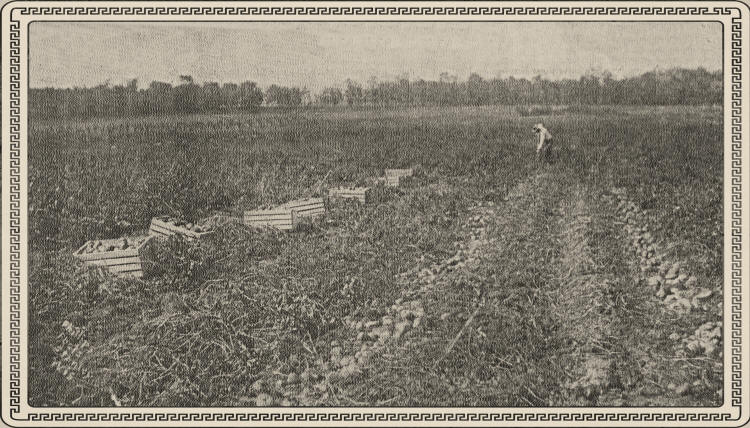
Potato Field in North End of Clark County.
“The clay soils of this formation constitute throughout good strong laud, very productive and durable. Because of its good drainage, practically every acre of it can be utilized for farm crops, and it gives every promise of being equal to the best and richest agricultural portions of the state or of the northwest. All farm crops are successfully grown. Grass and clover is an abundant crop, and dairying and stock raising is wisely becoming the chief source of the farm income. The small grains, corn and potatoes can readily be grown and should be raised in rotation with the feeding crops for dairy stock, sheep, and swine. Small fruits and garden truck are easily grown, and upon well selected sites the hardier fruit trees can be grown with success.”
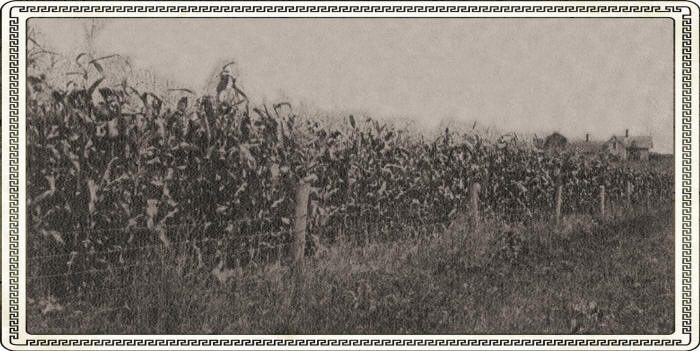
A Corn Field Near Owen, Wisconsin.
The sandy loam soil generally contains sufficient clay to retain the required amount of moisture for crop production. Splendid water is found at depths ranging from 15 to 60 ft.
Second only in importance to soil is climate. The average period between killing frosts varies from 120 to 130 days, a period of sufficient duration to ripen all farm crops including early varieties of corn. Clark County is in the same latitude as southern Minnesota, and the length of growing season is as long, as shown by climatic records of the weather bureau combined with the topographic maps of the U. S. Geological Survey. The average annual rainfall in Clark County will vary from 28 to 34 inches, and in its seasonal distribution, about half of the total falls in May, June, July and August.
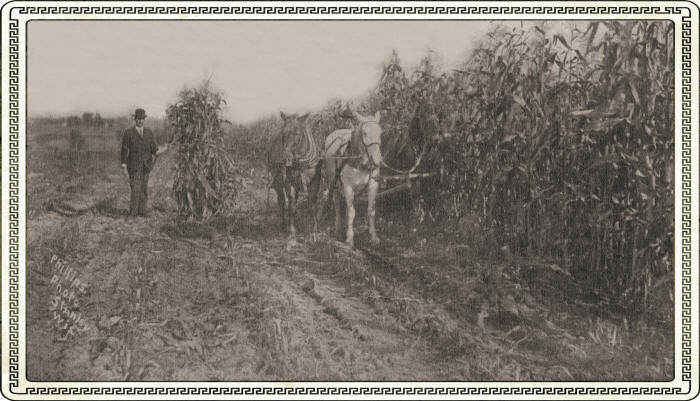
Harvesting Corn for the Silo on the Peter Thompson Farm near Thorp, Wisconsin.
Clark County is adjacent to active markets, well supplied with railroad facilities, and is developing a splendid system of highways. This proximity to market means less feeding and shrinkage of live stock in transit, opportunity to take advantage of favorable prices and minimum charges for transportation. There are 31 rural free delivery routes; 13 weekly newspapers; 12 telephone lines; 206 common schools, and eight high schools.
This section, noted as it is for its forage crops, is fully as well adapted to the production of special crops including clover seed, dry and canning peas, cabbage, sugar beets, and potatoes. Every opportunity is afforded for diversified farm crops. Briefly, this is a country of small farms, well tilled, with an average yield per acre equal to and frequently surpassing the high priced regions of older states.
THE STANLEY COUNTRY
For a number of years The Stanley Republican, W. A. Bridgman, editor, has been advertising “The Stanley Country”, comprising part of Clark county and parts of adjoining counties. Insofar as anything written about Clark County in these publications is concerned, we heartily concur, and as to the remainder of the Stanley Country, there is no question at all but that after Clark County, the Heart of Wisconsin, the Stanley Country is God’s own good country. Clark County and The Granton News congratulate the Stanley Country and The Stanley Republican, and hope that prosperity will smile on both of us alike. The same can be said of the counties to the north and west of Clark—Marathon, Wood and Taylor counties, all a part of the fertile central Wisconsin tract.
We are indebted to Mr. Bridgman for the use of several cuts of Clark county scenes.
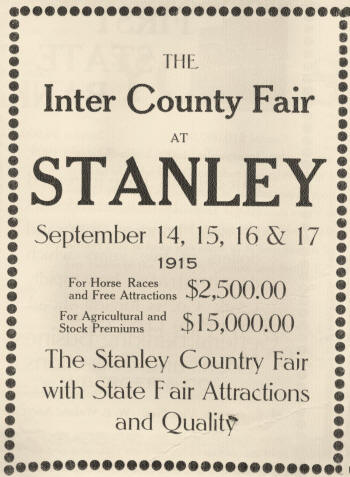
THE LYNN MUTUAL INS. CO. [Advertisement]
For thirty-seven years the Lynn Mutual Fire Insurance Company has been one of the most successful cooperated institutions conducted by farmers in the country. According to its last report, there were nearly 5000 policies in force carrying insurance for over ten million dollars, and the company is steadily growing. It has an enviable record of fair and just treatment of all policy holders, conservative, careful and economical management and sound business principles which has made it known throughout the country as a most successful organization.
It was organized in 1878, Thomas Reed being the first president and Charles Sternitzky the first secretary. The first twenty-five policies were issued to David Hillert, Maple- works, Henry Neinas, Fremont, W. Behling, Nasonville, Wilhelm Lachman, Lynn, C. Sternitzky, Lynn, F. Pofahl, Lynn, John Hoover, Lynn, Alonzo Brooks, Lynn, Ernst Barth, Nasonville, Johann Garbisch, Mapleworks, James Sternitzky, Lynn, John Jackisch, Lynn, August Yankee, Lynn, George Kleinschmidt, Lynn, G. Wischulke, Lynn, Fred W. Davis., Mapleworks, Hiram J. Seager, Neillsville, Ernest Sternitzky, Lynn, Louis and Thomas Reed, Neillsville. In 1900 Henry Sternitzky was chosen secretary in place of his brother who died, and six years later George Ure was elected to that position a I has held it since.
|
Henry Sternitzky President of Lynn Mutual Fire Ins. Co. |
George A. Ure Secretary Lynn Mutual Fire Ins. Co. |
John P. Kintzele Treasurer Lynn Mutual Fire Ins. Co. |
A charge of 25 cents per hundred dollars of insurance for five years is made when policy is issued and assessments made each year to cover the losses incurred, and for the past twelve years the loss rate has averaged two mills on the dollar, making the cost of insurance about one half of the cost of policies in the old line companies.
Five thousand dollars was the biggest loss paid by the company in its history although it paid losses of more than $10,000 due to one storm which swept the county, about twenty policy holders suffering damage to live stock and buildings. The company operates in Clark Co. and in Lincoln and Hock townships in Wood county. It has adjusted over 5000 losses and has had only one law suit. The expenses of the organization are only about $1800 a year, $1000 only being paid in salaries to officers. There are thirty-seven agents of the company.
The present directors are George A. Ure, Neillsville; C. W. Dewey; Neillsville; P. N. Christensen R.F. D. Marshfield; J. P. Kintzele, R. F. D. 1, Granton; Henry Sternitzky
R. F. D. 2, Granton, Herman Carl, R. F. D. 5, Neillsville; A. M. Steinwand, R.F.D. 2, Colby; William Vollrath, R.F.D. 2, Greenwood. The sum of 21,465.74 was paid in losses last year. Insurance is issued on detached dwellings, all farm property, country churches, school houses, stores, town halls, creameries and cheese factories and their contents except merchandise in stores. The secretary is under $5,000 bond and the treasurer $15,000.
The Lynn Mutual Tornado, Cyclone or Hurricane Insurance Company was organized by the directors of the Lynn Mutual Fire Insurance Co. on March 2, 1905 and started business on June 1 following. On the third of June there was a big storm up near Withee which damaged the property of seven new policy holders and losses aggregating $484.50 were promptly paid. Since that time, however, there have been no assessments levied until 1914, losses aggregating $1,527 being paid in the year 1912. In 1907 there was quite a cyclone went twisting through the county and did a lot of damage but by singular good fortune to the company, not one of its policy holder, suffered any damage. In 1914, however, there was a storm which caused 103 losses in one day, aggregating $7,962.42. This caused an assessment of three mills for that year.
The present directors are John Ure. R. F. D. Granton; P. N. Christensen, R. F. D. Marshfield; A. F. Dankemyer, Chili; Hy. Sternitzky, R. F. D. Granton; Wm. Vollrath, H. R.F.D, Greenwood, George A. Ure, Neillsville, William Kurth, R. F. D. Neillsville; Ernest Sternitzky, R. F.D. Granton; William Schlinsog, R, F.D. Granton, Henry Sternitzky is president, George Ure, secretary and Ernest Sternitzky, treasurer. In its last report, the company had 1966 risks carrying $3,392,500 insurance. The salaries paid are 25 cents per policy for the president, 50 cents per policy for the secretary, 8 per cent of premiums received for the treasurer and two dollars a day and expenses for the directors. The company is authorized to operate throughout the state of Wisconsin and is actually operating in Clark, Eau Claire, Wood, Marathon and Portage counties and is gradually extending its field. It has 48 agents at present.
THE VILLAGE OF WITHEE
It was in the summer of 1870 that the first permanent white settler came to what is now the, town of Withee. He was James S. Boardman and he came from Minnesota. Geo.
W. Richards and David R. Goodwin were the next comers and every year brought a few more. Winneoka post office was established in 1874 with Bernard J. Brown as post master. He kept the office at his farm and added a small stock of goods which he sold to the neighboring settlers. Previous to this the settlers had received their mail through the post offices at Chippewa Falls and Greenwood and had packed or toted all their provisions from these points. On November 23rd, 1880, the first passenger and freight train ran over the new line of the Wisconsin Central railway, now the Soo line, from Abbotsford to Chippewa Falls and opened up development of that timbered country with a rush.
The settlement at Withee thrived and soon became a prominent station on the new road. It was named after N. H. Withee who was county treasurer for several consecutive terms and enjoyed the entire confidence of the electors of the county. He came from Maine and was a school teacher. W. S. Tufts came from Manitowoc county in 1878, two years before the new line was operated and quickly took a leading part in the development of the settlement, engaging in lumbering, farming and the mercantile business. He was postmaster, and ran the hotel and store and operated a large farm and engaged quite extensively in lumbering and was a member of the county board all at the same time and later was elected to the office of sheriff which position he filled with honor. His son William is now one of the most enterprising citizens of Withee.
The village has a bank, 8 general stores, a drug store, restaurant, grocery and fruit store, hotel garage. a newspaper, two blacksmith shops, flour and feed store, jewelry store, boot and shoe store, saw mill and electric light plant.
Business Directory
Ayer, O. L., Lumber and Gen. Store.
Beilfuss, Walter & Co., Gen. Store.
Christenson, John, General Store.
Conrad, William, Saloon.
Erickson & Thorson, General Store.
Hansen, Andres, Restaurant.
Hanson Photo Co.
Jalling J. E., Fruits and Groceries.
Jensen Bros., Drugs.
Jorgensen, Nellie, Hotel.
Kuehl, Charles, General Store.
Laneville, J., Saloon.
Larson, Charles, Blacksmith.
Madson, C., Contractor.
Martin, R. Blacksmith.
Mertens, P., Meats and Grocery.
Nielsen, E. E., Jewelry.
Nielsen, G. E., Flour and Feed.
Paulsen, P. A., Saw Mill.
Rayemski, A., General Store.
State Bank of Withee. [Advertisement]
Stephenson, John, Garage.
Withee Construction Co.
Withee Co-operative Co., Gen.
Withee Electric Light Plant.
Withee Lumber and Fuel Co.
Wolter, Aug., Gen. Store.
Zasaba, John, Boots and Shoes.
A FEW WORDS REGARDING THE EDUCATIONAL SIDE OF CLARK CO.
By Professor M. H. JACKSON of The Wood Co. Training School
I remember asking a prominent man who had just finished a talk in which he had ridiculed country schools and country conditions, if he really thought that country education had gone backward. This was a long time ago but I shall not soon forget his emphatic reply:
“Bless you, no sir” said he, “the country school is as far ahead of the country school I attended as a caboose beats a wheelbarrow, but we want to make it a “Pullman.”
The poor belabored country school has turned out a tremendous army of successful men and women in spite of its drawbacks inefficiencies. My interests have always been in the country, and my work is now out in the country. There are heroes and heroines out there whose names will not be published in books or carved on tablets of brass or stone. There are girls from Clark County who have worked their way through higher institutions of learning who have prepared themselves for it by sawing wood in the woods with their fathers and brothers. I am speaking of two whom I know. They are both successful teachers now. They are not afraid of snow and mud in their walks to and from school.
Not all who try make good teachers. There are tragedies in life even at its best, but I want to say with emphasis that no braver person ever faced a school than the army of country school teachers of Central Wisconsin. I know them. I meet them often at teacher’s institutes, and I meet many of them in their schools, and I am glad to bear testimony to their singleness of purpose strength of character and kindness and willingness of heart.
We have been told that there are no reserved seats in heaven. Probably there are not, but I want to say right here that if there are, I know of hundreds of country teachers who live below have not walked in shoveled paths, whose rooms are not electric lighted and steam heated, who do their own janitor work in dust and smoke, who reach the school house early in all kinds of weather, I say I know hundreds of these whose pay does not measure up to that paid scrub women in our capitol at Madison, and they deserve to be in at the distribution of coupons for reserved seats to any good places here or hereafter.
Clark County is situated in the heart of our big grass region. Its splendid soil will support a much larger population that now we think. The county is developing rapidly, and so are her schools. Fine buildings and equipment are rapidly taking the place of the old, and her school boards are demanding better and better teachers for the salary paid.
I am glad of this opportunity to congratulate you all including your efficient County Superintendent, her corps of able country teachers and your country school boards for your efforts in building up a better and more efficient country schools in Clark County.
MEMBERS OF COUNTY BOARD
John Verkuilen, Chairman.
L. Emerson, Town of Beaver.
H. A. Frome, Town of Colby.
Aug. Anderson, Town of Dewhurst.
Dan Cook, Town of Eaton.
Peter Hotchkiss, Town of Fremont.
Otis Slocomb, Town of Grant.
Wm. Buss, Town of Green Grove.
Ignac Cesnik, Town of Hendren.
H. D. Lockman, Town of Hewett.
Jens Stigsen, Town of Hixon.
Frank Tonn, Town of Hoard.
J. W. Short, Town of Levis.
Chas. Buss, Town of Longwood.
Wm. Neitzel, Town of Loyal.
Henry Sternitzky, Town of Lynn.
Otto Baehr, Town of Mayville.
Otto Hatlestead, Town of Mead.
Fred Theiler, Town of Mentor.
C. G. Frantz, Town of Pine Valley.
H. F. Bohn, Town of Reseburg.
Elmer McVean, Town of Sherman.
Albert Manthey, Town of Seif.
R. C. Schreiber, Town of Sherwood.
Matt Greisch, Town of Thorp.
Frank Pickett, Town of Unity.
Aug. Beyer, Town of Warner.
T. M. Winters, Town of Washburn.
R. Suckow, Town of Weston.
Mike Graikowski, Town of Withee.
John Verkuilen, Town of Worden.
John P. Kintzele, Town of York.
A. J. Young, village of Abbotsford.
Joel J. Shafer, City of Colby.
F. M. Chase, village of Dorchester.
H. F. Stabnow, City of Greenwood.
F. W. Draper, Village of Loyal.
John Marx, City of Neillsville.
H. M. Root, City of Neillsville.
C. H. Sturdevant, City of Neillsville.
W. G. Royer, Village of Owen.
W. H. McCutcheon, Village of Thorp.
O. C. Graham, Village of Unity.
C. Madsen, Village of Withee.
AFALFA IN CLARK COUNTY
By L. F. Graber, dept. of Agronomy, Wis. College of Agriculture
Alfalfa is now a pioneer of Clark County, one of those strong, vigorous, healthy growing pioneers that will help make Clark County one of the leading dairy counties in Wisconsin. Clark County lands which grow clover so abundantly will also grow alfalfa. However, alfalfa growing should not be attempted on newly cleared lands. Such soils should first be planted to cultivated crops or grain and clover for a number of years to get the subdued and in a good condition of tilth. The settler had best depend on clover for hay until his farm his farm has become well established and then he may profitably begin to grow alfalfa for ‘s dairy or beef cattle and sheep. Every farmer in Clark County should make it a practice to mix two pounds of alfalfa seed per acre in with the timothy and clover seed they plant each year. This will produce a sprinkling of alfalfa plants throughout the entire field which will gradually develop the proper in inoculation in the soil so necessary for future crops of alfalfa. With an abundance of lime in soils and proper inoculation and well drained land alfalfa can be grown most any where in Clark County if good judgment and common sense is used in seeding. The College of Agriculture, Madison, Wis., will supply to any farmer in Clark County information in how to test the soil for alfalfa growing as well as how to inoculate with various methods and grow alfalfa to the best advantage. Farmers should avail themselves of every opportunity to secure this information which will prove so important to them in securing good stands this valuable crop.

Second Crop of Clover on Farm of Peter Frost, Withee, Wisconsin
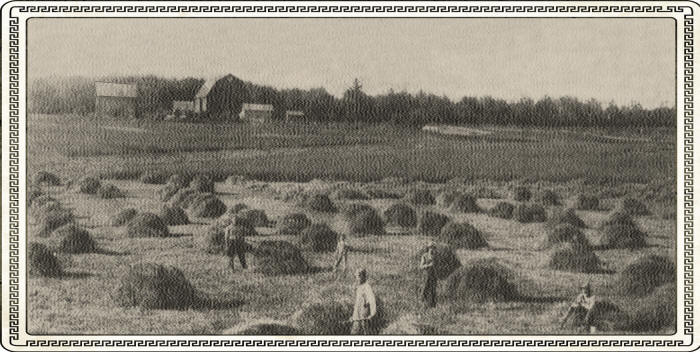
A Clark County Hay Field.
An Oat Field in Clark County, Wisconsin.
Alfalfa should follow some well sated crop such as corn, potatoes or sugar beets or tobacco where the weeds have been gotten well under control. Fall plowing is preferable and if land has an abundance of lime the alfalfa can be seeded with one bushel of barley per acre with hood results provided the seed or the soil has first been properly inoculated. Oats may also he used as a nurse crop, but it should be cut for hay when headed out to give the alfalfa every opportunity to develop. A more certain method of growing alfalfa is to seed the crop alone about the middle or later part of June. The soil is harrowed or disked at frequent intervals to destroy the weed growth. Lime is added if necessary and the seed or soil is carefully inoculated. The alfalfa should he sown at not less than 20 pounds per acre, and with the abundant rains a crop can usually be harvested the last of August. Alfalfa should never be cut later than the first week in September.
|
There is no crop which Clark County farmers can grow that will work so hard for them as will alfalfa. Producing three crops of the most valuable feeding hay in the world for dairy cattle, alfalfa will prove, and is now proving to be a most worthy crop. The beginner if he desires to reap the numerous benefits which come with successful alfalfa growing must study the needs of the crop, which are much more exacting than are those of the native plants such as clover and timothy. If he does not appreciate the importance of inoculation and lime and proper seeding methods he had better not attempt growing alfalfa in Clark County or in any other county in the Middle Western States. Play fair with alfalfa, give it a square deal and you will be well rewarded for your efforts. Before you plant it find out all you can about alfalfa. There is a state alfalfa growers association known as the Wisconsin Alfalfa Order, with headquarters at Madison, Wis. whose membership co-operates in experimental tests on alfalfa for information summarizing the experiences of thousands of alfalfa growers in Wisconsin. Alfalfa is becoming of increasing importance to the dairy farmers of Wisconsin. It has helped to make Wisconsin the leading dairy state in the Union. It has furnished an abundance of the most nutritious hay to feed the dairy cattle which are more numerous in Wisconsin than any other state. It is one of the important feeds that has been the basis of the fact that Wisconsin produces more cheese (one half the total supply of the U. S.) and more butter, has more cheese factories (one half of all the cheese factories in the U. S. are located in Wisconsin) and creameries than any other state in the Union. Clark County offers excellent opportunities to the home seeker and is ideally located in a state surrounded by the world’s greatest markets for farm products such as Duluth, Superior, St. Paul, Minneapolis, Chicago, and Milwaukee and numerous lake ports to the east and north. Wisconsin is the home of the dairy cow, of diversified crops, of alfalfa, clover, corn, and the silo, — the land of fertile soils which are kept fertile. |
|
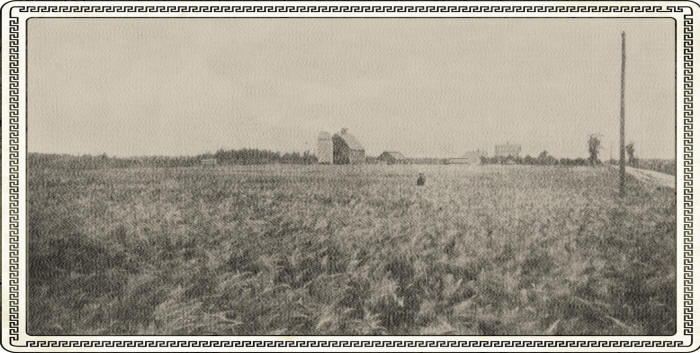
Barley Field of William Haas, Town of Withee.
HOW CLARK COUNTY WAS NAMED
My attention is called to the brief history of Clark County which appears in the first pages of this publication. It is stated that this county was named after the explorer Clark of the Lewis and Clark expedition. I am certain that Clark County was named after Moses Clark, one of the early settlers here, a brother of A. W. Clark who resided on the Clark farm two miles south of Neillsville at the Cunningham creek. I came to Neillsville in 1873 and for the first three years lived with my uncle James O’Neill the First settler of Clark County and the founder of Neillsville. He located at Neillsville in 1844 and was a member of the legislature in 1849. He must have been active in procuring the organization of Clark County in 1853. I have often heard him say this county was named after Moses Clark. I am corroborated in this by some of the oldest settlers. Mrs. Nettle Youmans, daughter of Dr. B. F. French, one of the early settlers informs me that she has heard her father say this county was named for Moses Clark. Mrs. Emma F. Robinson who has resided here since 1858 and who was intimate with the Clark Family states that the county was named for Moses Clark. I have interviewed Fernando Wage and Mrs. Wage. Mr. Wage came here in June 1856 and located on the farm adjoining the Clark place. He states that there is no doubt this county was named for Moses Clark. Mrs. Wage says that there was a gathering of school children at Mr. O’Neill’s residence and that Mr. O’Neill talked to them about the early history of the county and told them the county was named after Moses Clark.
It is beyond dispute that Price county was named after William T. Price and Rusk county after Governor Rusk. Also that the town of Eaton was named after Elijah Eaton, the town of Withee after N. H. Withee, the town of Warner after M. (Mark) Warner, and the town of Hendren after Rev. W. P. Hendren. These are matters which were well understood at the time these counties and towns were organized. The common understanding by the old settlers that this county was named after Moses Clark and the statement of such men as James O’Neill the first settler and so prominent a man as Dr. French are sufficient proof of the fact. It is only within a few years that I have heard of the claim that the county was named for Clark the explorer, or Satterlee Clark who resided in the southern part of the state.
I will add something further in the way of accuracy. The founder of Neillsville was born in Lisbon, St. Lawrence county, New York. He told me that in the winter of 1838-9 he chopped cordwood along the Mississippi river near New Orleans; that he came up the river to La Crosse and thence to Black River Falls in 1839 and built a sawmill south of that city on the east side of the river. He came with his brother Henry to Neillsville in 1844. Henry O’Neill later went to a place a few miles north of Chippewa Falls and went into the lumber business.
Alexander O’Neill lived at Prairie du Chien and not Burlington. I visited his widow and children there in 1865.
The first white child born in this county was Isabella Jane O’Neill now Mrs. Wilson S. Covill, who is living at Shelton, Washington.
James O’Neill, Neillsville.
CATTLE, CORN AND CLOVER
Bring in the Cheese and Creamery Checks in Clark County
Nothing is so dry and uninteresting reading as statistics and the reader would be wearied by mere figures of the wealth and prosperity of Clark County, “The Heart of Wisconsin.” But figures are necessary in order to give the stranger a basis for forming a true opinion of this garden spot.
It is to the gentle cow that Clark county owes its greatness. From the time when the last of the drives of pine down Black River and its tributaries sounded the knell of the good old logging days, until the present day when assessor reports a total value of all taxable property in the county at thirty three and a third million dollars, it has been the hearty Holstein and the gracious Guernsey with occasional placid Jerseys and other breeds, which has developed the wilderness into a garden spot. The wonderful growth of grasses and clover; the bountiful supply of good, pure, clear water, the unusually healthful climate, invigorating and pleasant winter and summer, makes Clark County the natural center for profitable dairying.
From the official reports of the county clerk given under oath to the county board, there are about 4,500 farms in the county, which has a population of 35,000 people. There are over 600 silos and that number is increasing at the rate of about 100 a year. There are 76 cheese factories and 27 creameries, and over 4000 patrons contribute their product to these institutions resulting in the manufacture of 2,455,922 pounds of butter and 7,111,147 pounds of cheese last year. These patrons received in creamery and cheese factory checks the sum of $1,768,941.
The report states further that there are 31,958 milk cows in the county, representing a value of $1,062,960; that there are 28,162 other cattle -and 13,736 horses, 4,184 sheep and lambs and 10,708 swine over 4 months old.
THE GRANTON NEWS
By G. F. Grassie, Neillsville
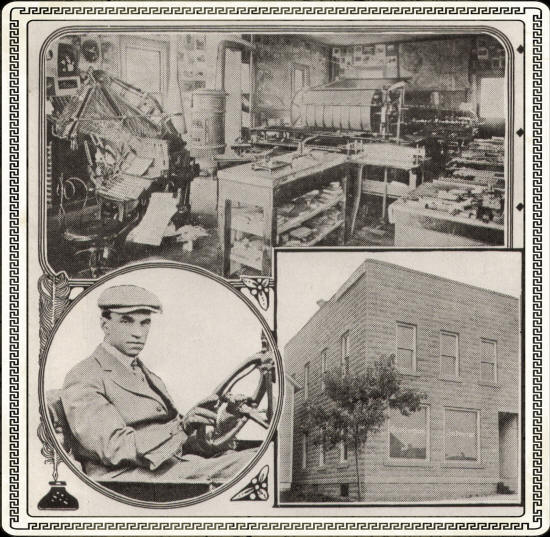
With diffidence to his profession, the editor of the Granton News and the publisher of this special Clark County edition, demurred at having any publicity in regard to himself or his paper in this issue, but his associate, his better half and close friends insisted that he come in for a share of the glory. For a decade or more he has been slowly but surely plugging for Clark County and is just now getting his stride. During the next few years, you are likely to hear from Publisher Baer as an enthusiast when it comes to promoting and developing and exploiting Clark County, the heart of Wisconsin. The zenith alone is the limit to his ambitions.
As evidence that he is even now known as a progressive and pushing printer, a man who has done things which no other man in the country has done, bought and operated a linotype machine in a print shop in a town of less than 500 people, read the following write-up from The Publishers Auxiliary, the “most thoroughly read paper in America” Gentle reader, meet Mr. Baer:
The accompanying illustrations show the home of the Granton (Wis.) News, a portion of the up-to- date printing plant and F. J. Baer, owner and publisher, who has made an unusual record in conducting a newspaper in a town of less than 500 population.
About ten years ago Mr. Baer started in business at Granton, having at that time, as he puts it, “no money, but a lot of ambition.” He borrowed enough money to purchase an old newspaper outfit, which was installed in a small dark basement room, and began publishing the News. The facts that he was in a small town and that there were ten other healthy newspapers being published in Clark County did not dampen the ardor of Editor Baer, He applied sound business principles in all dealings and mapped out a campaign of bard work for himself.
Today Mr. Baer owns the two-story concrete building occupied by the News, a fine residence, a modern printing plant and an automobile, all of which is clear of debt. It has always been a hobby of Editor Bear to have a model equipment for the News, particularly as he does all of the work himself, with only the assistance of his wife in gathering local news. This ambition has been realized and the plant of the News, including linotype, Walter Scott news paper press, 10x15 jobber, newspaper folder, perforator, stapling machine, automatic punch, paper cutter and two gasoline engines, is equal to equipment found in towns many times the size ot Granton. A short time ago an official of the United States census bureau called on Mr. Baer and told him that he had been in thousands of country newspaper offices but had never found so complete and modern a plant as that of the News in a town of less than 500.
The News is a model weekly newspaper, neat typographically, with a substantial paid-up subscription list. It is liberally patronized by local business men and makes a strong feature of country correspondence. In size it is a six-column eight-page paper, using Printed Newspaper Service supplied by the Milwaukee off ice of the Western Newspaper Union.
Mr. Baer’s success with the Granton News is a striking example of what grit, perseverance and an ambition to “get there” will do when properly applied, and his achievements should be an inspiration to every small town ‘newspaper publisher.”
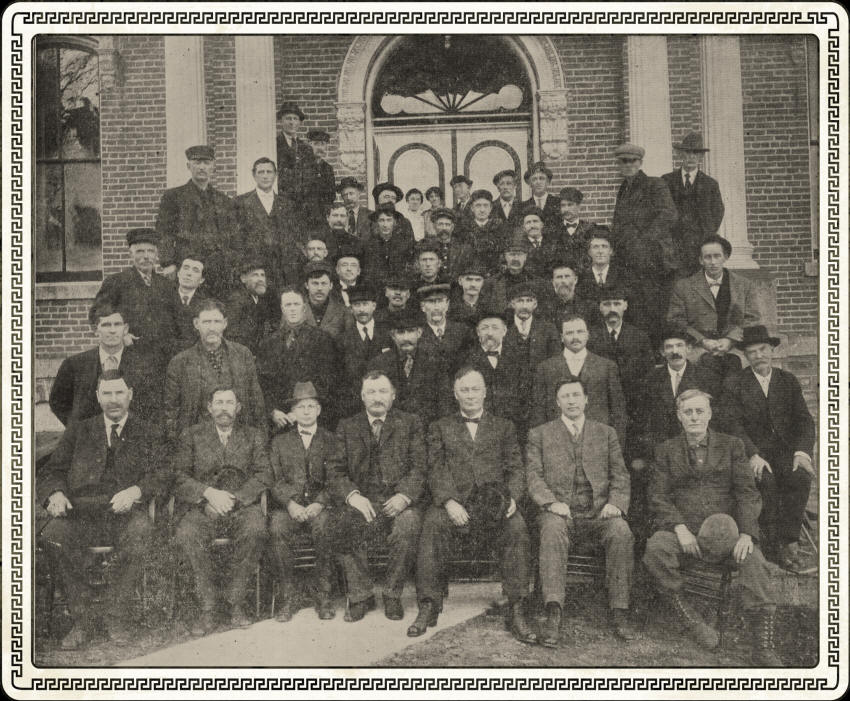
1914 Session, Clark Co., Wisconsin Board Members.
| Top row from left to right: Peter Hotchkiss, Fremont; A.A. Gates, Sherwood; C.F. Frantz, Pine Valley; Otis Slocomb, Grant: Florence Brown and Alice Neverman, Stenographers; Dr. W.R. McCutcheon, Village of Thorp; Joel Shafer, City of Colby; A.J. Young, Village of Abbotsford; L. Emerson, Beaver; J.W. Lynch, Neillsville, 1st Ward. Second row: Frank Tonn, Hoard; F. Bohn, Reseburg; Jens Stigen, Hixon; J. Syth, Eaton; Thomas Winters, Washburn; Ed Wollenberg, City of Greenwood; J.P Kintzele, York; stranger. Third row: Dan Cook, Eaton; Charles Kessler, Colby; P. Paulson, Withee Village; John Vandosky, Warner; W.G. Royer, Owen Village; H.M. Root, Neillsville, 2nd Ward; J.W. Short, Levis; F. Graikowski, Withee; John Mund, Weston; W.M. Ritchie, Hewett; Frank Pickett, Unity; William Wegner, Lynn; P. Peterson, Dorchester Village. Fourth row: Louis Hantke, Sheriff; E. McVean, Sherman; Otto Hattlested, Mead; Otto Baehr, Mayville; A. Manthei, Seif; William Neitzel, Loyal; Dr. A.F. Fuchs, Loyal Village; Fred Theiler, Mentor; Ignatz Cesnic, Hendren; Matt Greisch, Thorp; Geo. Anderson, Dewhurst. Lower row: Harry Hewett, Ex-Sheriff; John Verkuilen, Chairman, Town of Worde; C.R. Sturdevant, Neillsville, 3rd Ward; William Buss, green Grove; M.E. Wilding, county Clerk; Ole C. Anderson, County Treasurer; Geo. A. Ure, Clerk of Court. |
FACTS ABOUT CLARK CO.
Climate—agreeable and healthful. Average temperature is but five degrees lower than that of central Illinois and Iowa—from 10 to 20 degrees above zero in the winter months and from 60 to 70 degrees in the summer months; over 110 growing days between frost and frost. The mercury sometimes drops to 20 or even 30 degrees below zero but this is for only a day or two at a time and is unusual. The high altitude and dry air contribute greatly to the comfort of living in central Wisconsin.
Average rainfall of 40 to 41 inches, evenly distributed during the growing season. Long droughts are unknown.
Water— a good supply of pure clear water can be readily obtained—usually at a depth of from 20 to 50 feet from the surface. Black River and numerous tributary streams drain the county.
The people are thoroughly cosmopolitan; all good Americans— hard-working, honest, friendly, enterprising and intelligent. The German-Americans probably predominate among the foreign born population, but there are many Scandinavians, Bohemians, Polish and people of other nationalities.
There is a fine system of country schools and city graded and high schools.
Population………………………… 35,000
Assessed valuation (31 towns)…… $28,978,840.00
Number of farms …………………..4,500
Number of silos ……………………600
Number of creameries ……………..27
Number of Cheese Factories ………76
Number of patrons contributory …...4,275
Number of cows contributory ……...32,260
Number of pounds of milk received. 150,547,380
Amount received by farmers from Creameries
and cheese factories per year ……....$2,000,000
Value of much cows ……………….$1,200,000
Value of other cattle ………………..$500,000
Value of horses …………………….$1,200,000
Value of sheep ……………………..$15,000
Value of swine ……………………..$100,000
Farm Products / Av. yield per acre / Total yield
Wheat………… 20.5 bu. …………..10,000 bu.
Corn …………...43.1 “ ……………400,000 “
Oats …………...47.2 “…………… 1,500,000 “
Barley …………39.6 “ ……………100,000 “
Rye ……………20.1 “ ……………40,000 “
Potatoes ……….151.5 “ …………..300.000 “
Hay ……………2.1 tons ………….90,000 tons
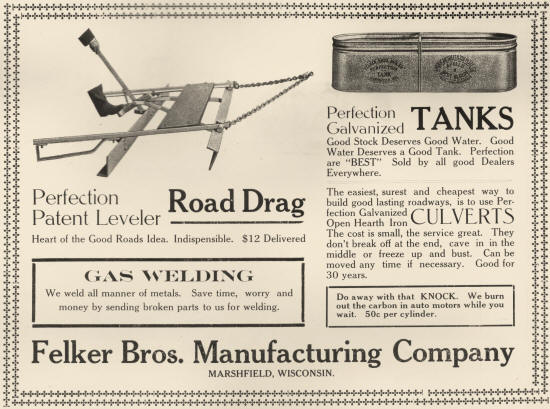
Felker Bros. Manufacturing Co., Marshfield, Wisconsin.

